Porsche 911 GT3 and Touring 2026 Review: Track drive
Porsche’s road and track flagship gets a mid-life nip and tuck, prevails in every way. How do we get one?
Dark clouds pushed by savage southerly gusts speed across the sky as garage roller-doors rattle in chorus. The hot sun has just been replaced by a full moon, hot brakes perfume the pit lane at Sydney Motorsport Park.
We’re here for our first taste of the new, ‘992.2’ generation Porsche 911 GT3 in full-fat bewinged and demure Touring guises.
Pitched to us by Porsche Cars Australia as a ‘speed-dating’ experience, it’s an abridged taste of the Stuttgart marque’s latest flagship combustion cars before a road drive later in the year.
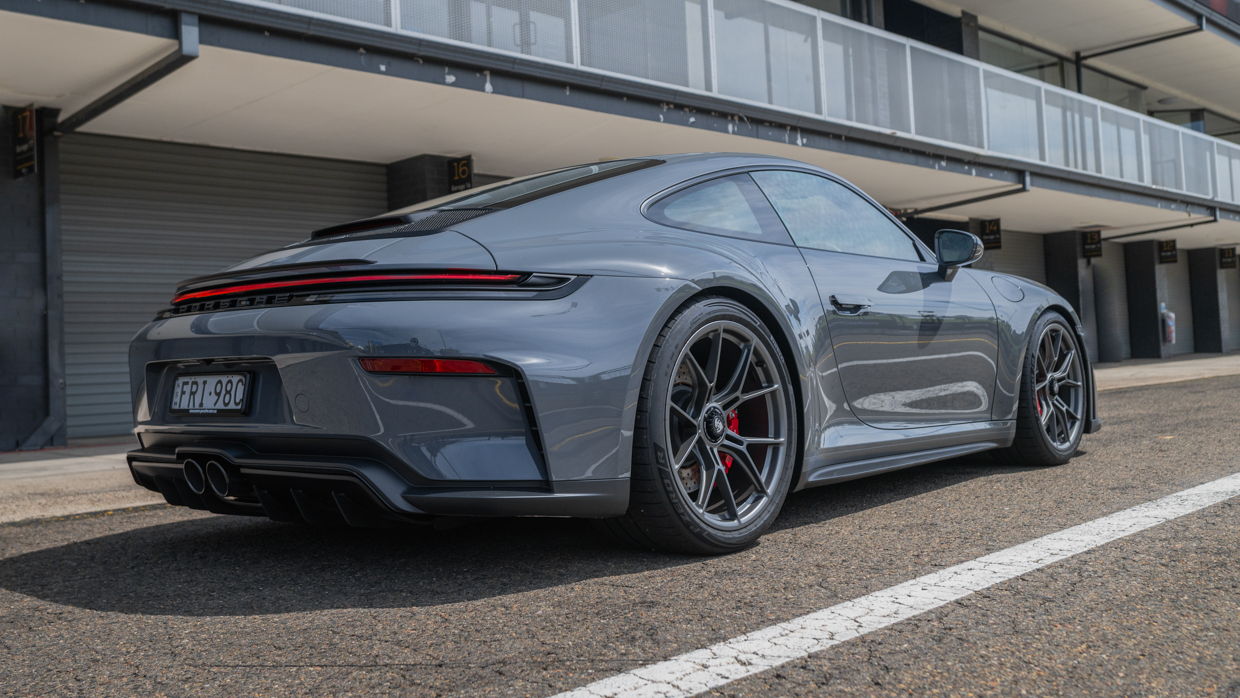
If you ignore the Cayenne, it’s the first time in GT-car history Porsche has offered back seats from the factory. They’re small, sure, but it means owners will be able to inspire the next generation more easily than before.
They’re fitted to the pair of Slate Grey Neo Touring pack GT3s, which look beautiful.
The retro wingless silhouette anchor them to their heritage, set off by classy Black/Cohibra Brown Exklusiv Manufaktur leather — a $28,070 option, if you’re wondering.
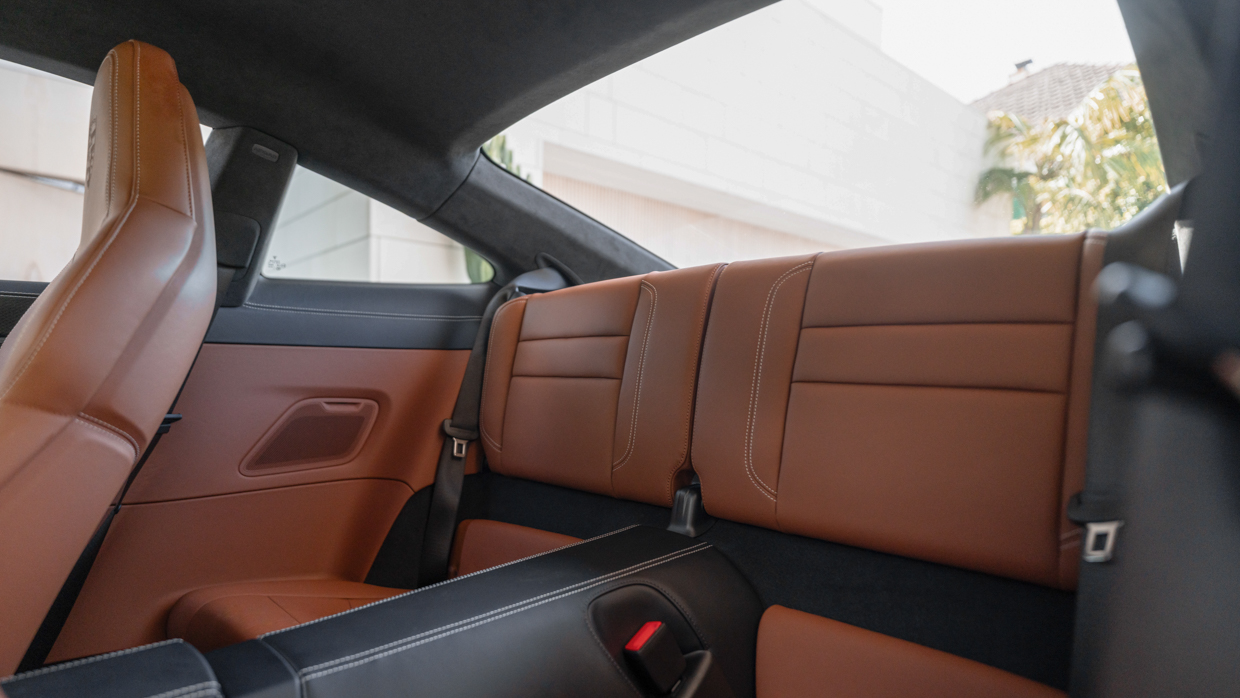

Should you wish to prioritise protection in a crash over back seats, Porsche now offers two roll-cage options, too. A steel arrangement in the Club Sport package (a no-cost option with the fold-forward carbon buckets) also bundles a six-point harness and fire extinguisher.
Alternatively, you can go lighter, electing for the $47,530 Weissach Pack with carbon roll-cage on the winged GT3, as seen on the Guards Red car.
This is pretty serious stuff, and the first time Weissach has been offered on a non-RS GT car.
Other goodies include carbon-fibre reinforced plastic (CFRP) suspension components (anti-roll bars, coupling rods, shear panels), mirror caps, front air blades, door handles, and side panels of the huge rear wing.
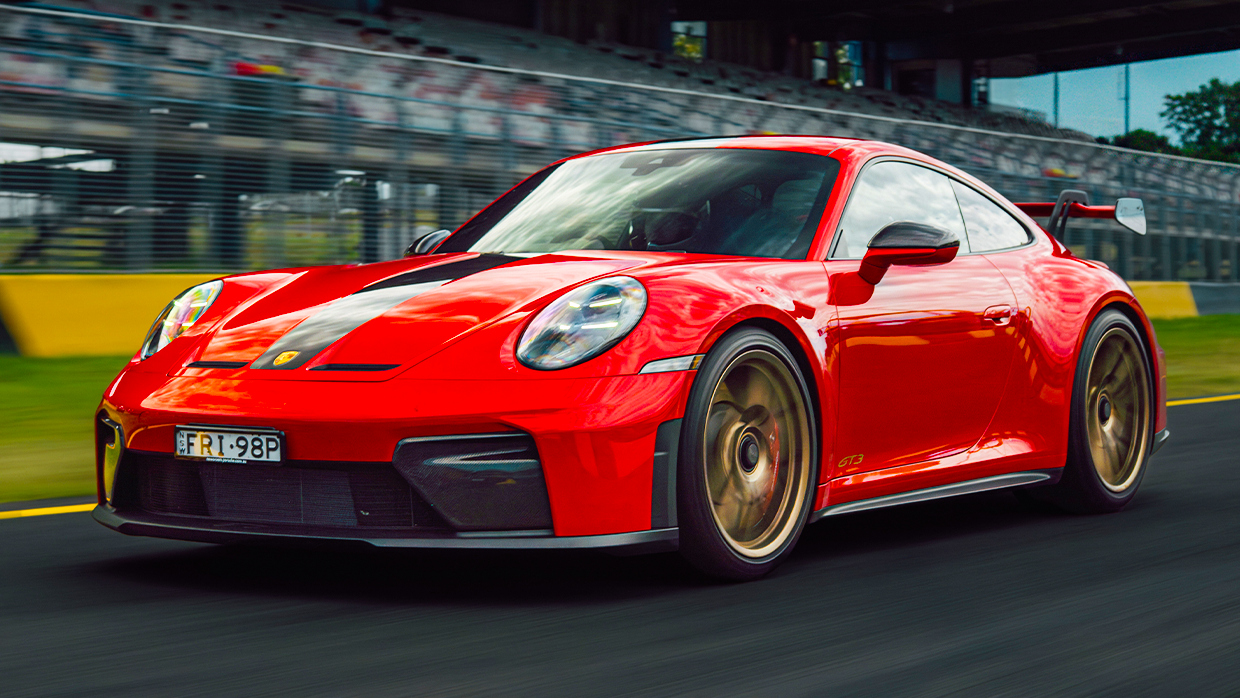

Optional forged magnesium wheels, as fitted, are a $33,840 option and save 9.1kg unsprung mass. For Touring buyers, a similar Leichtbau (Lightweight) pack is available.
Still, the new 992.2 911 GT3 is fractionally heavier than the car it replaces, tipping the scales at 1420kg in its lightest configuration (+2kg), or 1439kg without options.
Power from the 4.0-litre naturally-aspirated flat-six hasn’t increased, either, still pinned at a healthy 375kW.
Emissions regulations have led to a total of four catalytic and two petrol particulate filters, strangling 20Nm, now down to 450Nm. We’re clearly approaching the limit of naturally-aspirated machines.

It’s quieter, this new GT3, though nothing an aftermarket Akrapovic won’t fix. Plus, sink down into the supportive bucket seats with minimal (but adequate) padding and you can still feel the throbbing flat six inside.
The pews are power-adjustable for height, and manual slide, making it easy to get comfortable.
As our GT3 has come in hot from the previous session, there’s no chance to interact with the still-present twist-to-start in the GT3 — 911 Carrera, GTS and Turbo variants are now boring push-button affairs.
Time to take this 500-plus horsepower, rear-engined, rear-drive sports car with hot tyres onto the track. It’s a little daunting, especially as a droplet of water hits the windscreen.
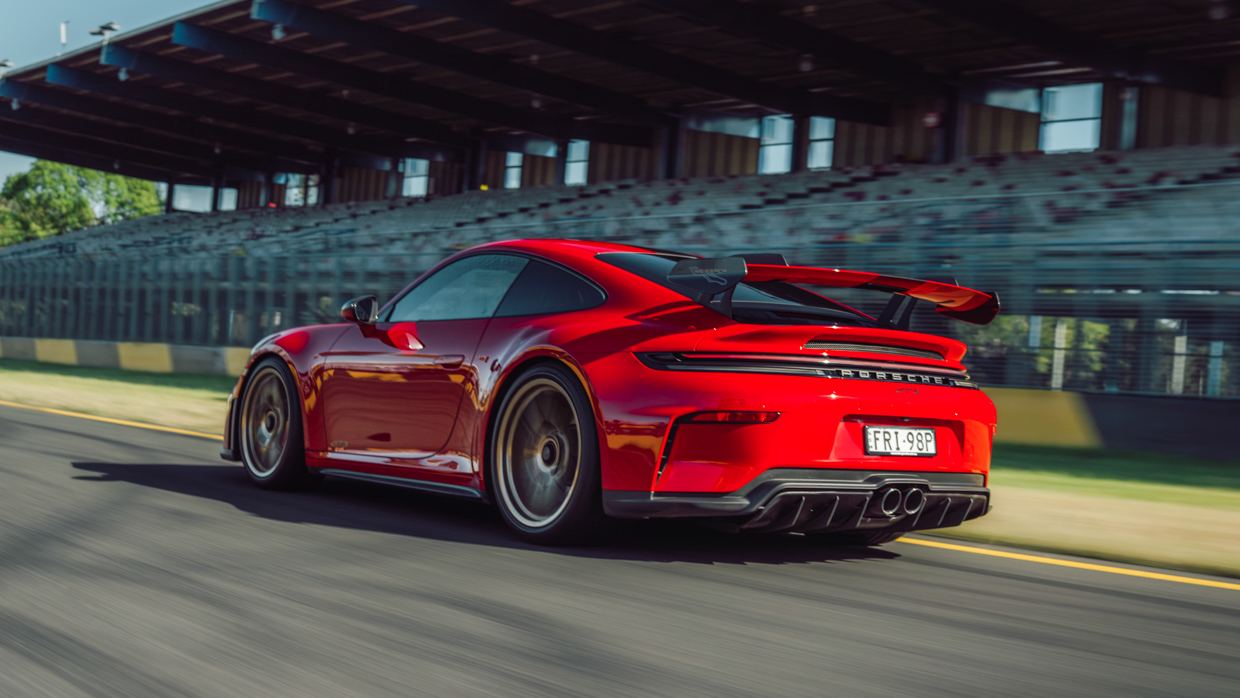
In the manual, winged GT3 first, the clutch bites right off the floor. Catch it with some throttle, before it stalls, and take off. Twist the wheel-mounted drive selector into ‘Track’ and, thankfully, that’s it for mode fiddling.
The 911 is refreshingly set-and-forget after bamboozling customisation of BMW M, Mercedes-AMG and Hyundai N products.
There’s an inherent rightness to the 911 GT3. You may have never driven one, or not done so in a very long time, and yet interacting with the steering, brake, clutch and gear lever is like shaking hands with an old friend. Totally predictable, entirely reassuring.
Auto rev-matching is on, but so perfect is the GT3’s pedal spacing and brake pedal support, heel and toe downshifts are second nature.
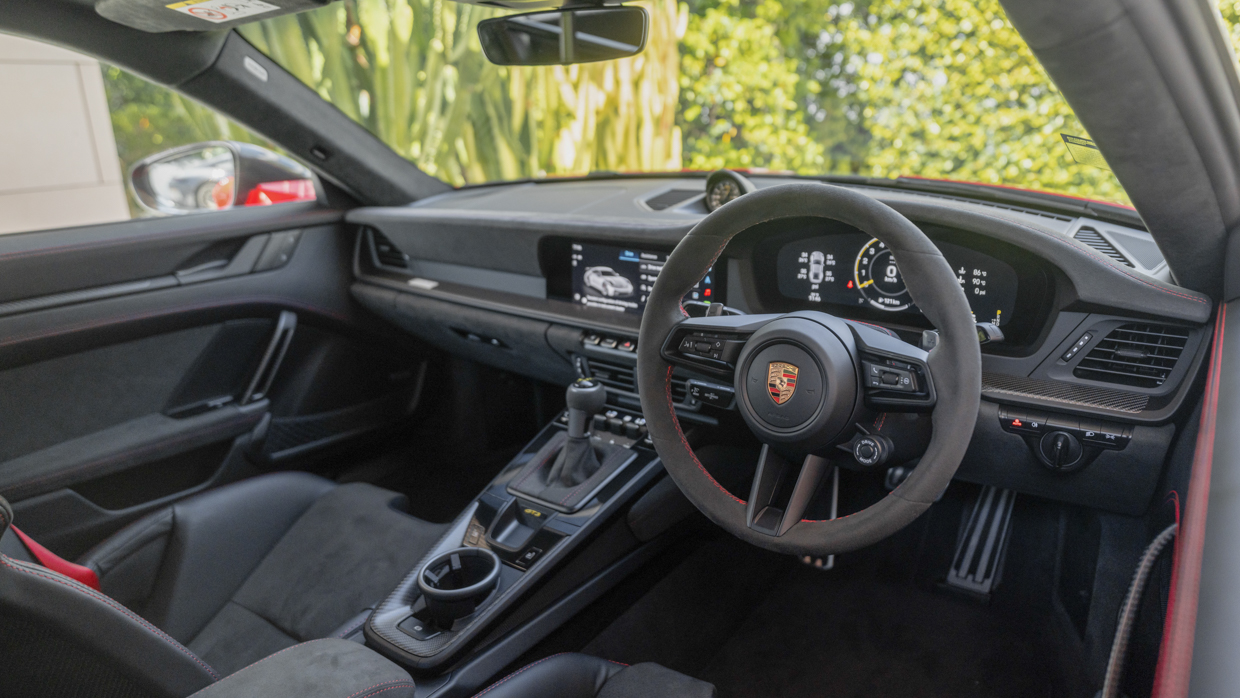
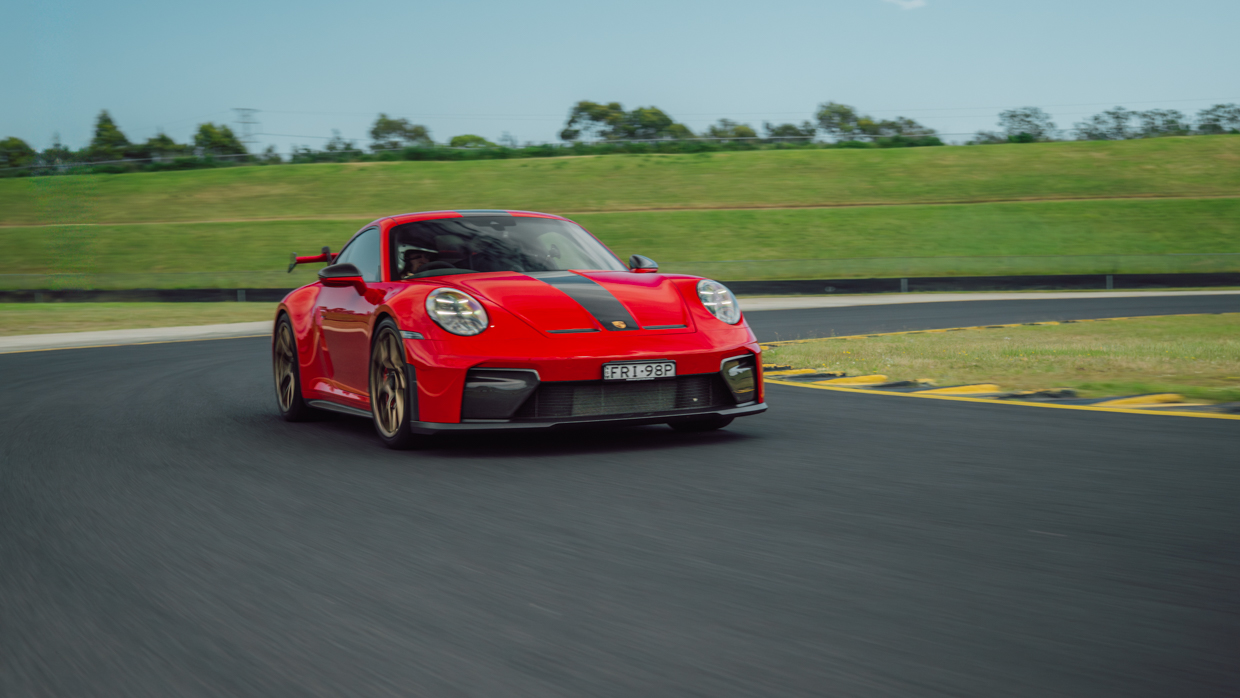
We’re told to keep the new GT3 in third gear through the tight, double-apex turn two on the GT Circuit and with the eight percent shorter final drive ratio from the 911 S/T, the new car pulls convincingly from the mid corner.
Equally satisfying is the slick, precise and light gearshift, controlled by the stubbier lever also borrowed from the S/T.
The shorter gearing negates that on-paper torque loss, and the new GT3 also benefits from revisions to the cylinder heads, individual throttle bodies and ‘hotter’ camshafts.
Drama is increased beyond 5000rpm as the engine comes alive. Cooling has been stepped up, too, for continuous lapping in hot conditions.
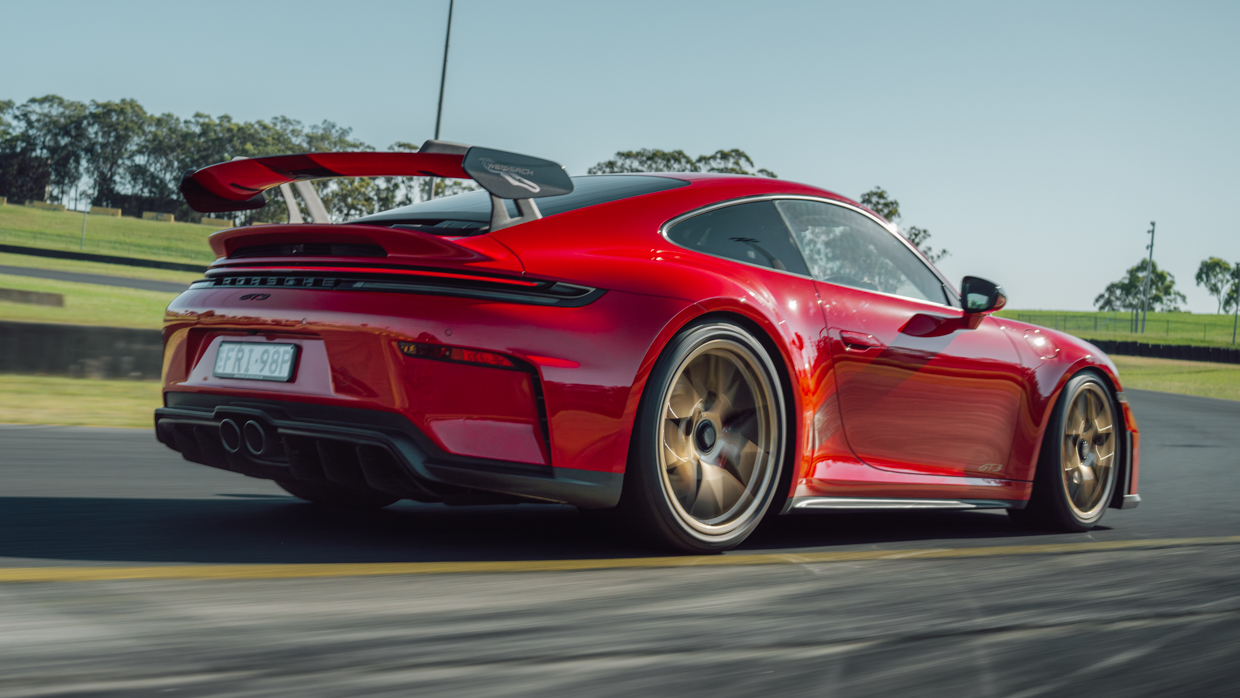
Just one lap in, the confidence the GT3 instills in the driver is absurd. It’s fast, sure, but crucially there’s no major drama after a dud braking point, or advancing the throttle too soon — just a nibble of understeer telegraphed delicately through the steering wheel.
A suggestion you might revise your technique.
I’m reminded of what Porsche Track Experience Chief and 2017 Bathurst 1000 winner Luke Youlden said in the driver briefing — the new GT3 doesn’t punish mistakes. It’s nothing like a race car in that sense, he says. You’d think that might make it boring. Nope.
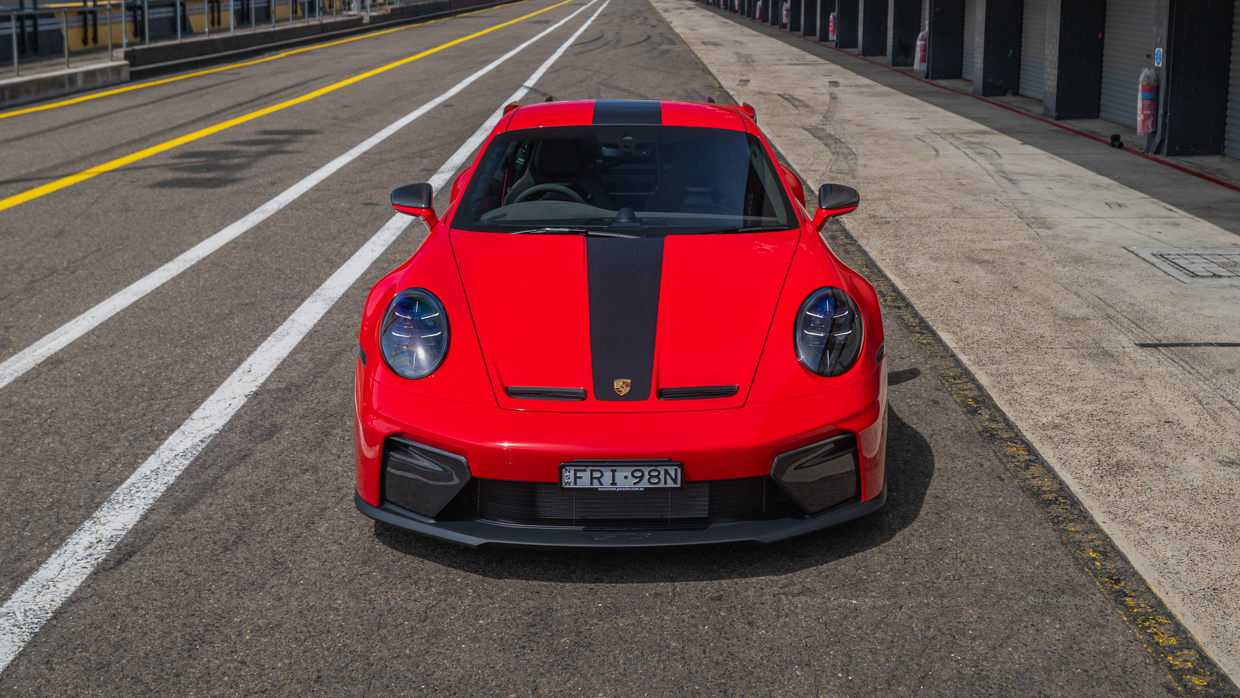
We swap places and I’m behind the lead driver now, the pace rises, the rear-engine balance becomes helpful under brakes, rotating the GT3 towards the apex and necessitating a hack of opposite lock as I overdo it into the downhill, on-camber turn eight.
That’s on me, not the car, and that’s satisfying.
A run through the high-speed turn-one at decent pace shows up the GT3’s superb balance and aerodynamic poise.
It feels like you could ramp up turn-in speed endlessly (latterly, Youlden proves 185km/h is a cinch). And just as we’re getting into the groove, the instructor’s hazards come on, and it’s back to the pits.
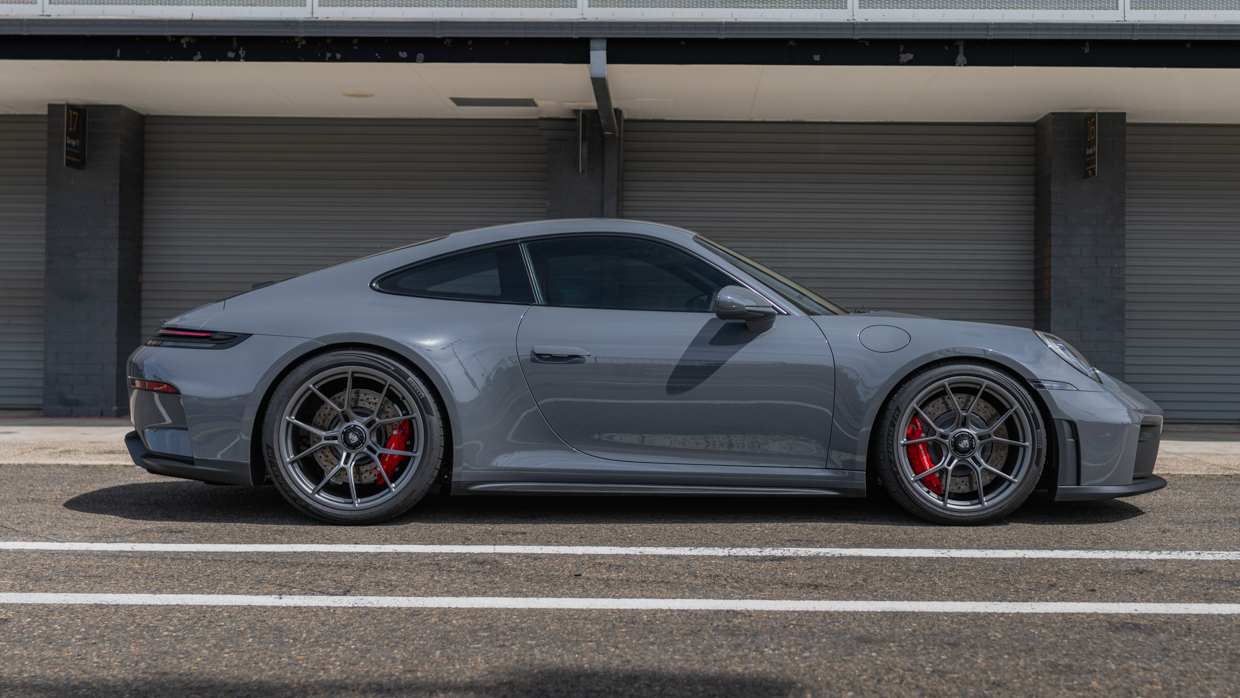
To round out the brief evening, it’s time in the PDK-equipped cars, this time a slinky Touring. Supple leather coats the 18-way seats which are plusher, yet rob some of the clarity of road feel you get through your bum.
Compared to the six-speed manual, the seven-speed PDK is half a second quicker from 0-100km/h (3.4sec) than the manual. What’s surprising is how significant that feels on track.

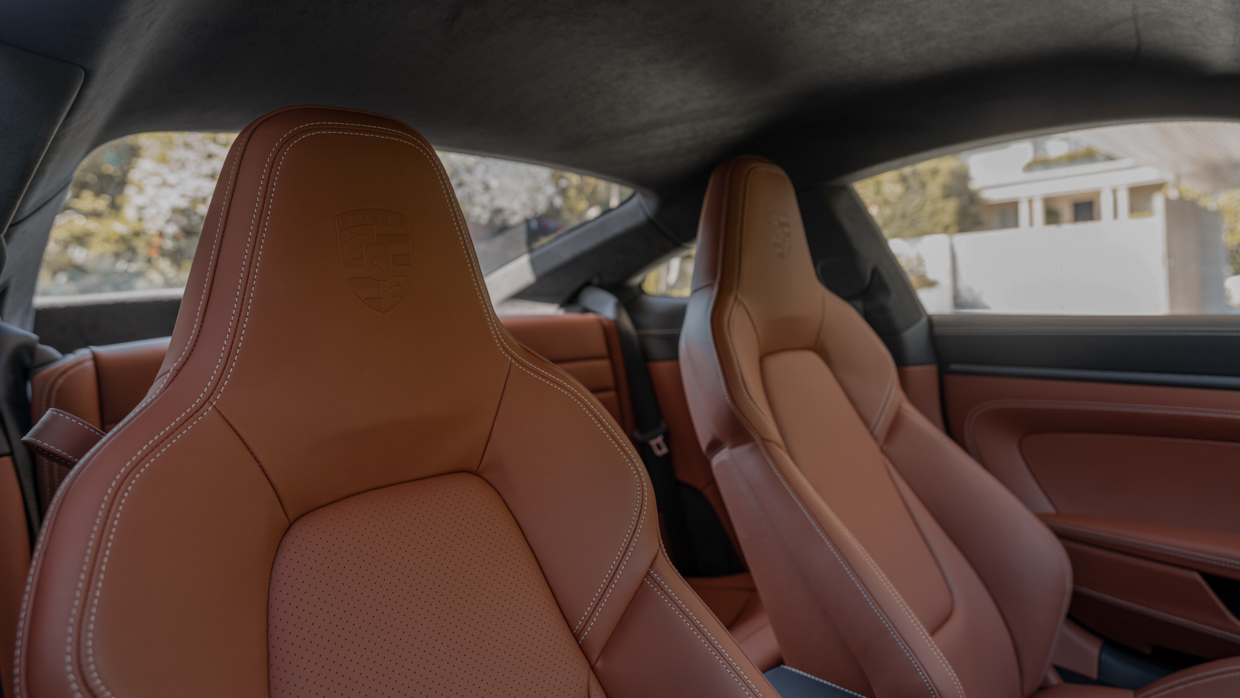
Pulling out of pit-lane, the PDK-equipped car is more urgent, more brutal, and more exciting because of it. Under brakes, the car picks the perfect downshift point. You’d say it was telepathic, if it wasn’t for the fact it works faster than the brain can comprehend.
There’s another hidden trick to the auto GT3, being the standard-fit PTV Plus electronically-controlled limited-slip differential as opposed to the manual’s mechanical item.
This adds another layer of sophistication, subtly turning impatient throttle inputs into mid-corner rotation instead of understeer.
Not to say the manual car isn’t entirely pliable, like putty in the driver’s hands, but the PDK’s rotation borders supernatural.

Without that massive wing, you’d expect the Touring to feel a little less stable at speed, but the difference is minimal at these speeds, at least in feel as Porsche’s GT department has refined the package for identical balance.
Big changes have happened underneath the new GT3s, with tweaked front spoiler lips, modified underbody fins and even aerodynamically-optimised rear trailing arms and double wishbone front suspension components.
Without a gear lever to wiggle about, confidence grows quickly in the Touring. Moving quicker, the precision and calmness of the talkative steering becomes an attribute, allowing the driver to guide the gripped-up front axle exactly where it needs to be.
The brakes help here, too. The spacing in the PDK essentially forces left-foot braking and the supportive pedal gives immense confidence.
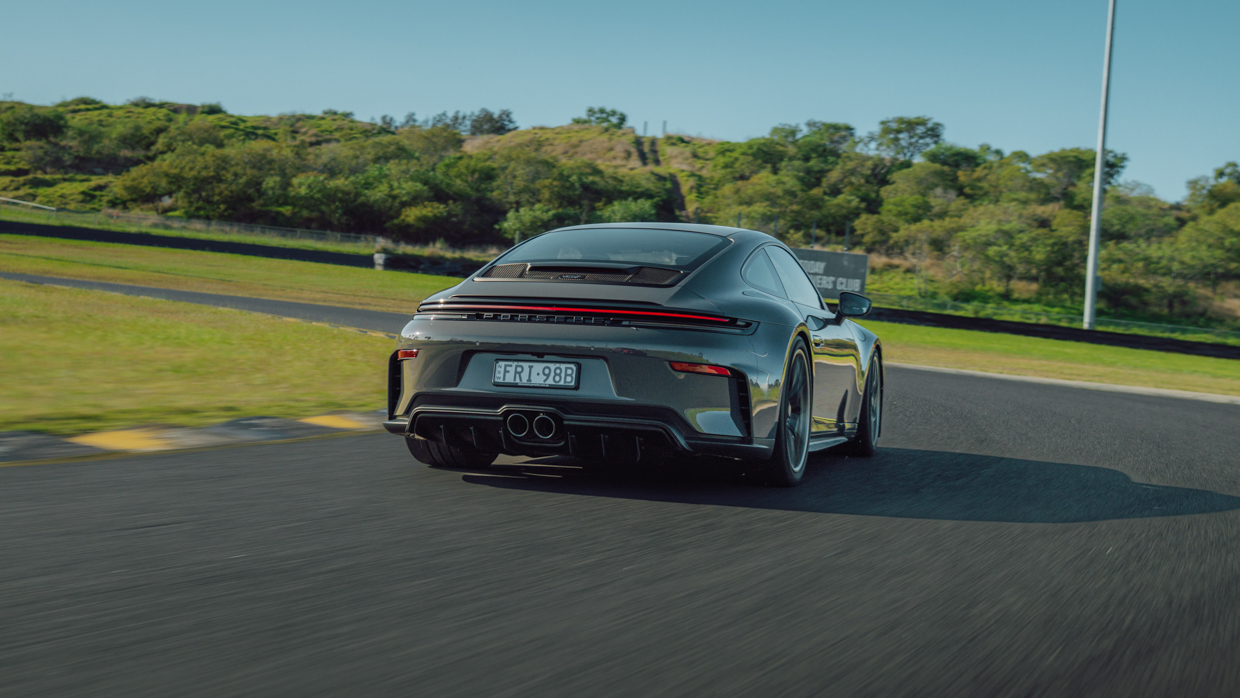
Porsche’s tweaked the pivot points on the front suspension for greater anti-dive, giving a flatter platform under brakes and therefore improving ease of trail-braking.
Now feeling totally at ease, some bandwidth can be dedicated to suspension set-up which is actually softer than before, responding to complaints of the pre-update 992 GT3 and incorporating learnings from the S/T with new, more capable dampers.
There’s also 25mm more stroke thanks to reprofiled bump stops. Adaptive dampers are standard and have three modes: Normal, Sport and Track.
Both Touring and winged GT3s now use identical set-ups as a result of the changes.
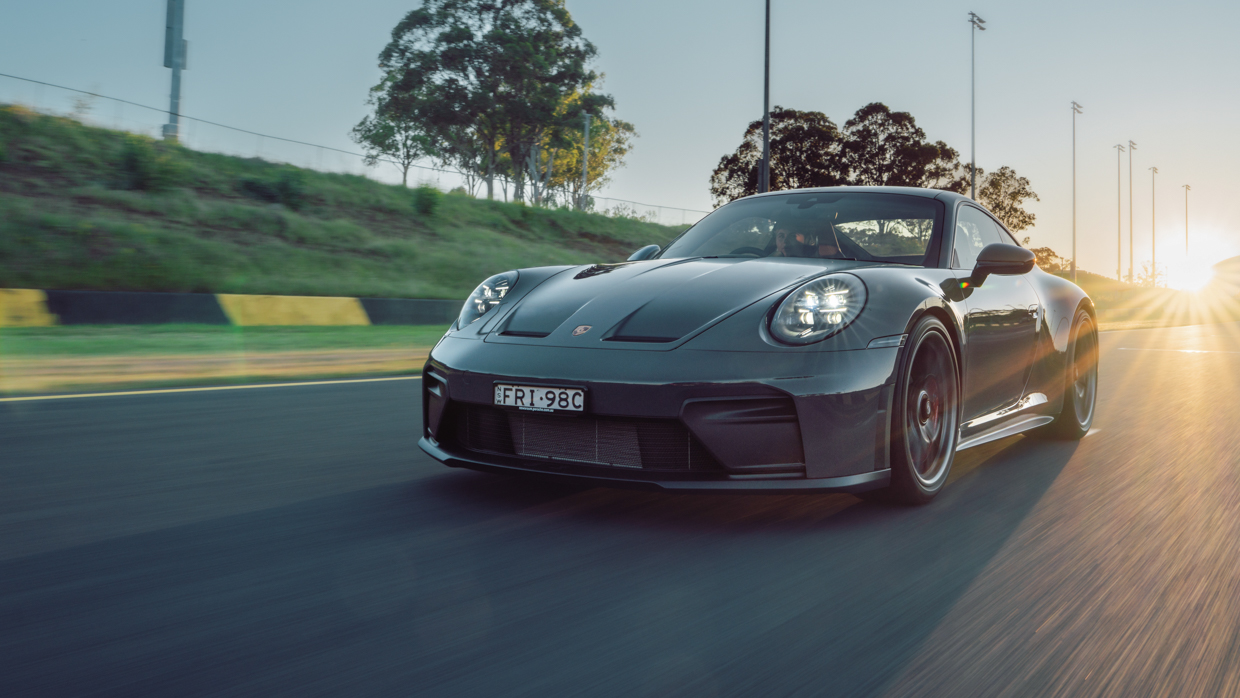
Even in Track, the GT3 gobbles up kerbs — from sawtooth to sausage — like Homer Simpson at a ’ball game.
In fact, feel-wise, it’s possibly one ever-so-slight shortcoming of this GT3. Over some of Sydney Motorsport Park’s mid-corner ripples, the GT3’s body does float a whisker more than is strictly comfortable.
That’s about as much of a nitpick as you could throw at any car. Plus, pure racetrack life is the game of the all-out GT3 RS…or an actual racecar.
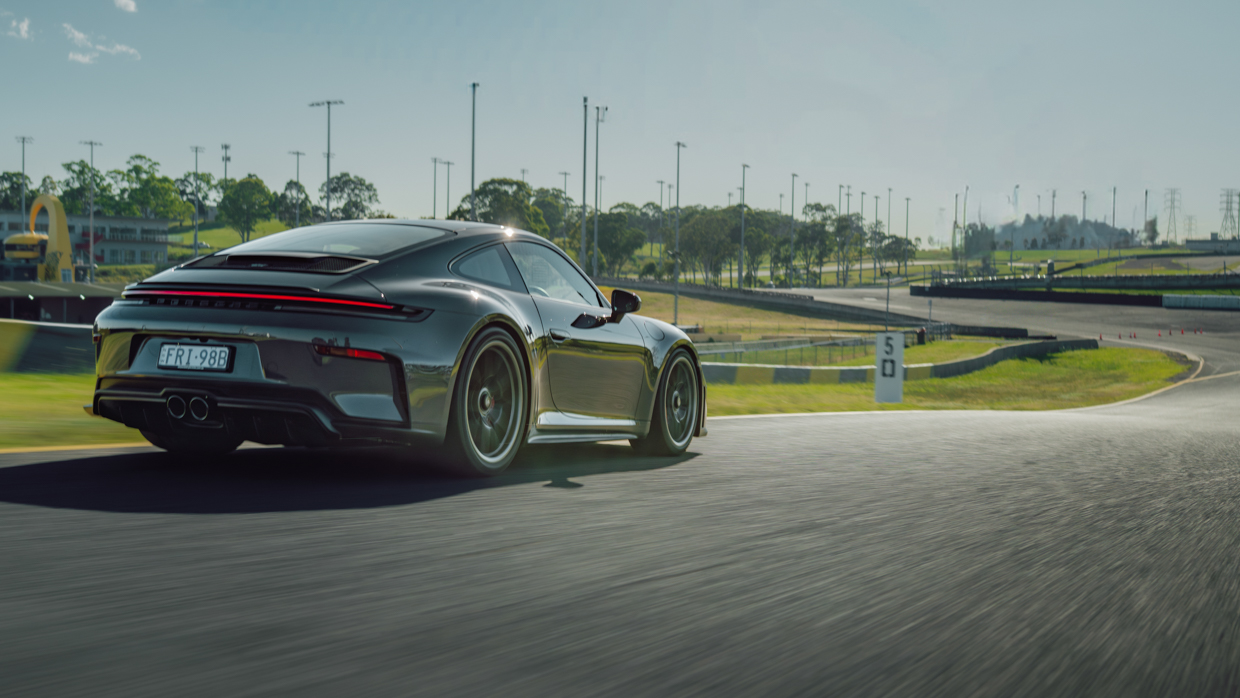
Suspicion is that this minuscule compliance trade-off will more-than pay dividends when we get the Touring out for a proper fang on our favourite roads.
At this point, the instructor’s hazard lights glow again, and after a 30-plus degree day the Pirelli tyres on the GT3’s 20-inch front and 21-inch rear wheels are decidedly worse for wear, but everything else feels tight as a drum.
Firm brake pedal, strident powertrain, suspension, like this car’s built to be abused and we didn’t even come close.
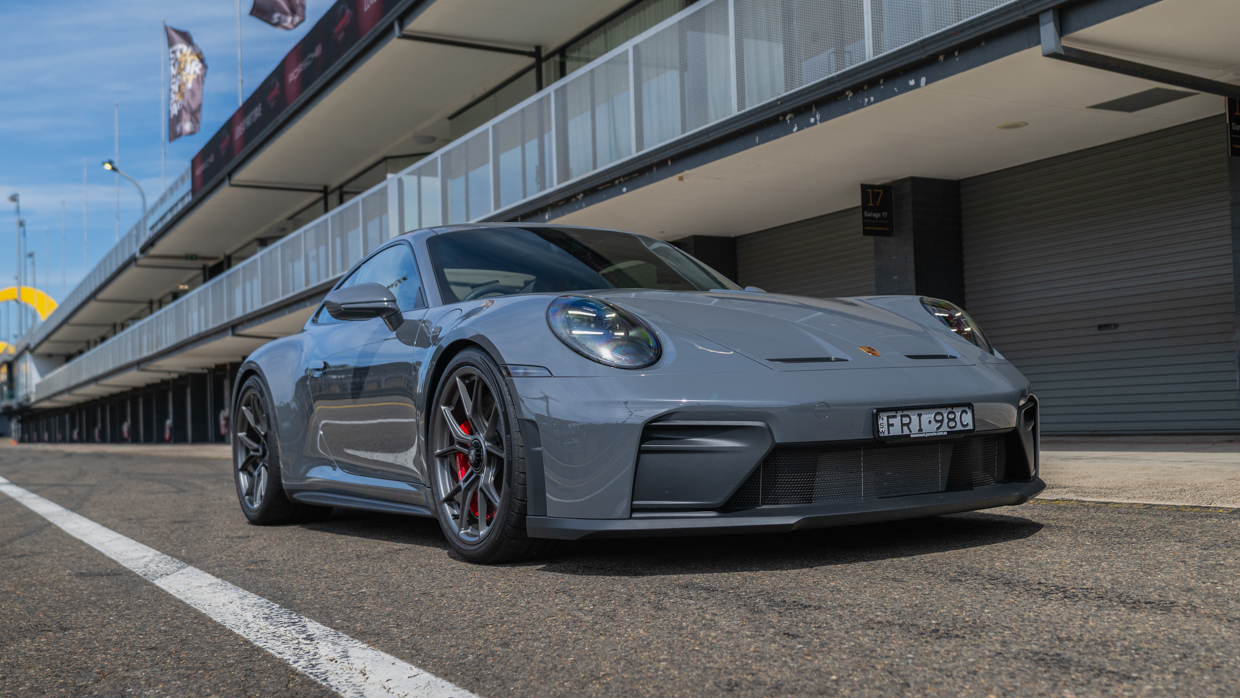
The other major sticking point for these GT3s is the price. Before you touch the configurator, we’re already talking $446,700, before on-road costs. The red GT3s are optioned up to $574,680, and the Slate Grey examples a staggering $626,150.
That’s beyond Ferrari 296 GTB money ($604,000), and when you look at the spec sheets, the Fezza produces an extra 235kW and has all the complexity of a hybrid battery. No-brainer? Not really.
As always, the Porsche 911 GT3 satisfies on a more cerebral level. It does so in an almost Toyota Hilux (and we mean this as a complement) way, with Porsche ensuring every component has been tested to destruction so you can hit the racetrack weekly (or more) and only really worry about consumables.
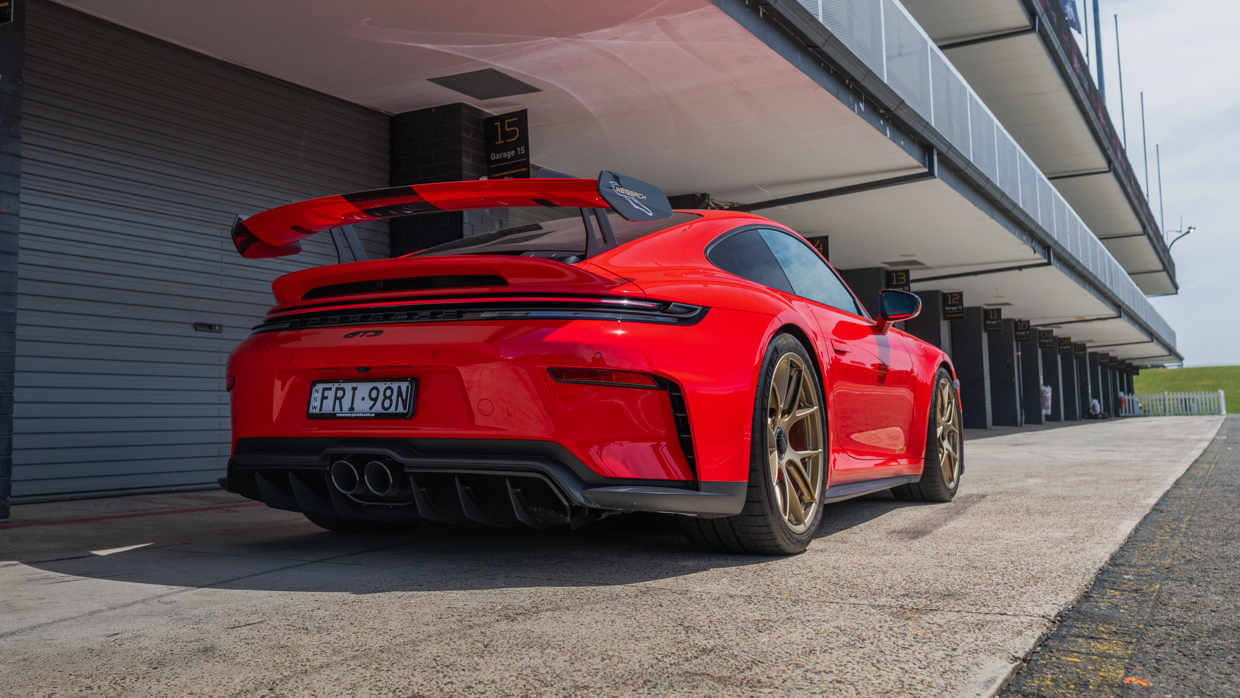
Even though it’s quieter, the 911 GT3’s 4.0-litre flat-six is still an intoxicating mechanical marvel. That manual transmission may be slower, but the satisfaction of commanding proceedings is worth the trade-off.
That the new GT3, in Touring or winged, manual or PDK, instills such immediate confidence in the driver is the biggest takeaway from our brief experience. Crisp, responsive, pliable and totally addictive, the Porsche 911 GT3 prevails on track. We can’t wait to get it out on the road.
Ford Mustang GT Fastback 2026 long-term review
1 week ago

Welcoming America’s sole remaining two-door V8 muscle-car – the Mustang GT in six-speed manual Fastback form – for a six-month stay on the Chasing Cars fleet
With the V8-powered Chevrolet Camaro, Dodge Challenger and long-dead Holden Monaro now just distant memories for muscle coupe lovers in this day and age, it’s something of a revelation that Ford still produces the Mustang, in both V8 and turbocharged four-cylinder versions.
It’s not just any old Mustang either – the latest seventh-generation S650 Mustang GT is a comprehensively re-engineered and visually refreshed version of its circa-2014 S550 predecessor.
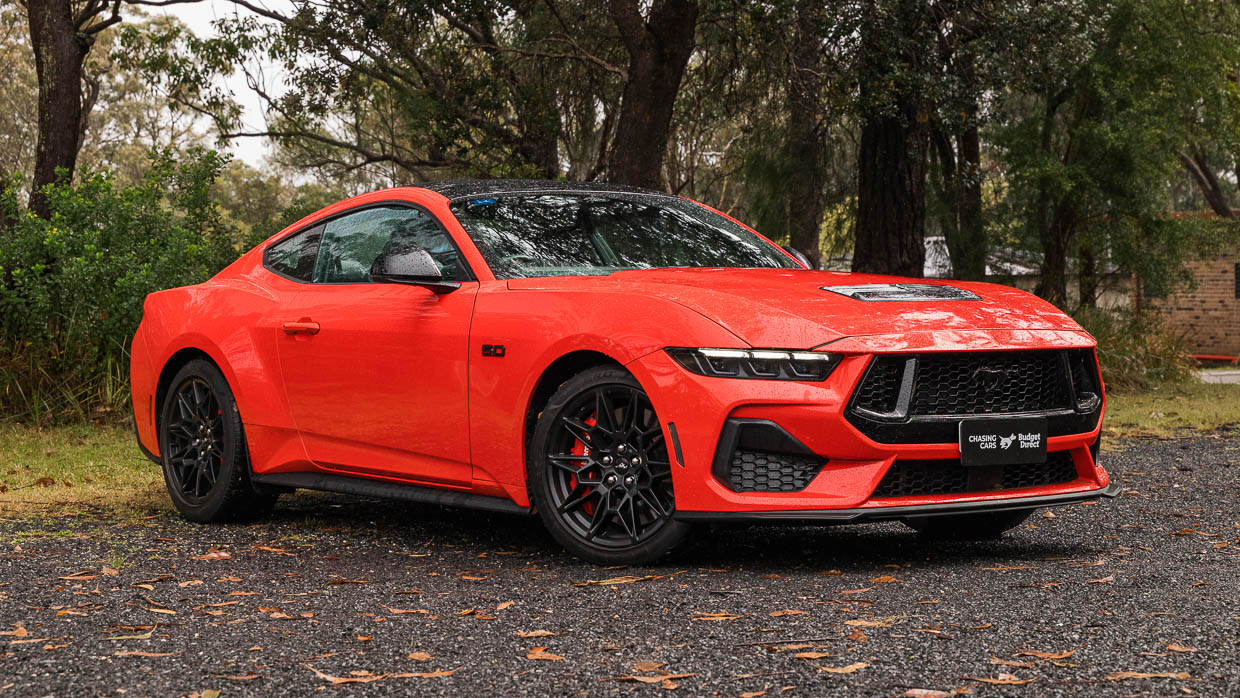
And Australia’s Mustang GT features all the dynamic good stuff to make it a proper sports/muscle car, not just a straight-line boulevard cruiser.
Fully independent suspension with a multi-link rear end, 19-inch alloys with Pirelli P Zero tyres (255/40 front, 275/40 rear), a limited-slip rear differential, and huge ventilated discs brakes (390mm front, 355mm rear) clamped by Brembo six-piston aluminium calipers up front and four-piston aluminium calipers in the rear is all proper performance-car hardware.
That’s all well and good when you’re testing the manual Mustang Fastback’s mettle at a racetrack or on a challenging twisty road, but what we want to know is: what is Ford’s venerable muscle coupe like to live with day-to-day?

Will this six-speed manual V8 make laborious demands of its driver like so many muscle cars have in the past? Or will it be a revelation in terms of character, communication and feel-good vibes that every cent spent fuelling it will be worth it? That’s what we’ll find out over the next six months.
We also plan to compare it against a Mustang Dark Horse Fastback manual – to see if this limited-edition sports version is worth the extra spend, given the near-certainty of an MY26 version returning to Australia.

And we also plan to switch into a 10-speed automatic GT towards the end of our loan, to see if the auto is better-suited to the muscular nature of the Mustang GT.
Month 1: Meeting Our Mustang
Settling into our Race Red Mustang GT Fastback manual and quickly discovering that a thunderous rear-drive V8 mainlines right to the core of what, for many decades, was Australia’s performance-car heartland … and it feels good. Really good.
- Kilometres this month: 1082.8km
- Fuel economy: 13.3L/100km
There’s been a bevy of SUVs, dual-cab utes and EVs in the Chasing Cars long-term garage over the past few years, which had me wondering if there might be an antidote to all this efficiency and utility. And there is – it’s the Ford Mustang GT.

This V8-engined two-door Fastback coupe (or convertible) is the polar opposite of what most people buy, yet Ford is on track to sell around 6000 of them in Australia this year – making 2025 Mustang’s best sales result this decade.
It really wasn’t that long ago that V8s made up a significant portion of our motoring diet – the final year of the Holden Commodore, for example, saw V8s account for between 30 and 50 percent of production at times, until it all came to a screeching halt in late-2017.
But in 2025? It’s Mustang GT or nothing. Or perhaps the limited-edition, sold-out (for now) Mustang Dark Horse. Or a Nissan Patrol. Or a European performance equivalent costing eons more than the GT Fastback manual’s $83,990 list price. See where I’m going here?
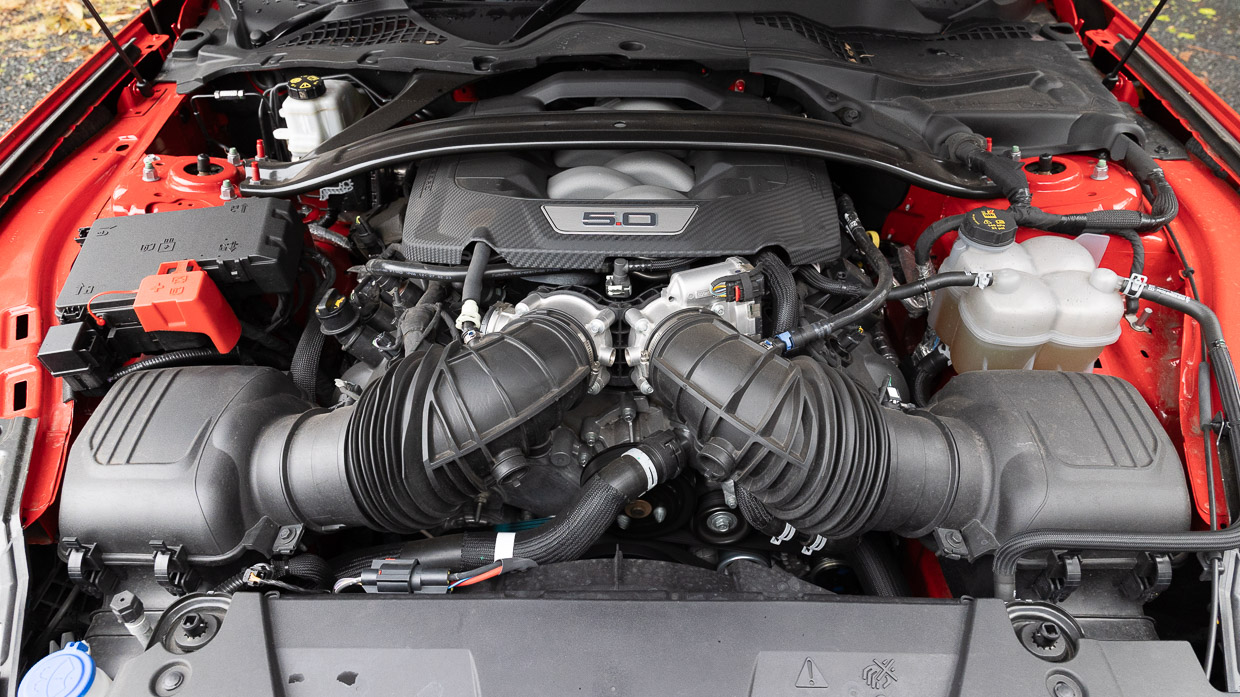
There’s some method to my madness in choosing a Mustang V8 manual. Firstly, it has a manual transmission, which is becoming increasingly rare, and ditto its V8 engine.
And secondly, I ran a previous-generation S550 Mustang GT Fastback manual as a long-termer back in 2017/18 – combined with various Mustang new-model launches and test cars, both stock and modified – so I know Ford’s pony car pretty well. And I’ll be able to spot whether the 2025 version should be sent to a meatworks or celebrated for its talent.
Our test car features a few choice options – namely a Black Pack ($1731), Recaro front seats ($2950) and, crucially, ‘MagneRide’ magnetic adaptive dampers ($2950) for the suspension.
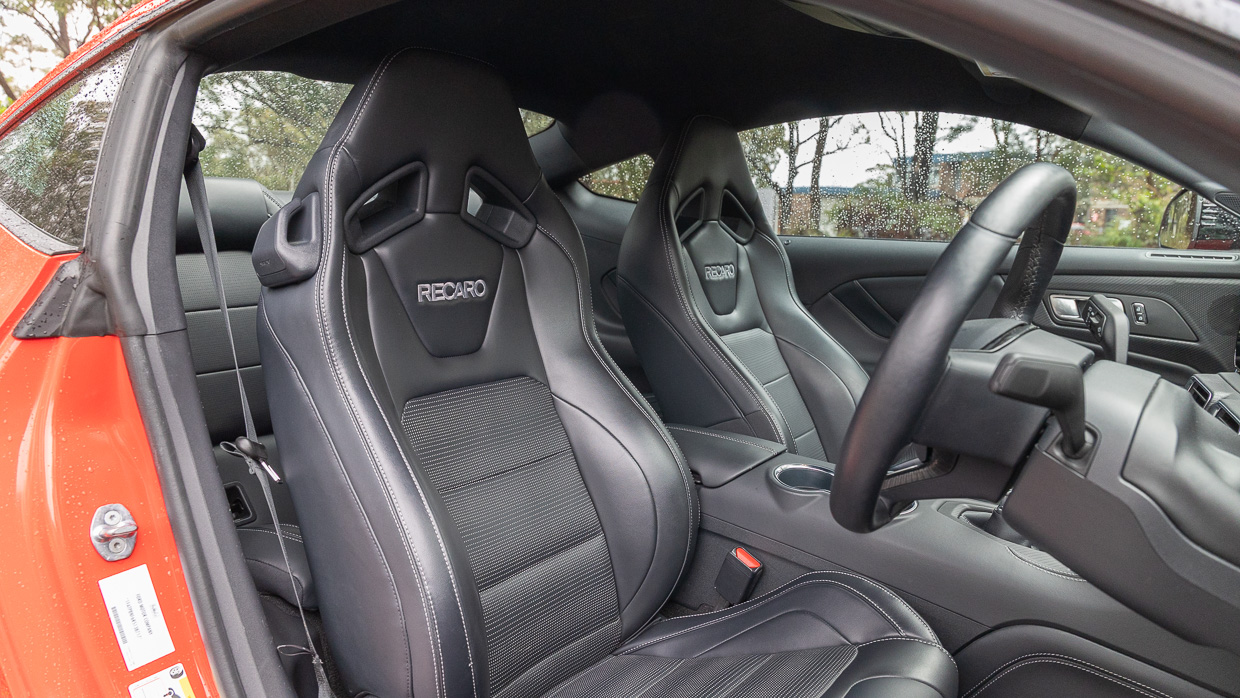
The black-out trim adds black badging, a black roof and mirrors, and matte-black wheels (which all look great with the standard Race Red paint), while the form-fitting Recaros look suitably sporty inside a cabin with a manual shifter – though they lose the heating/cooling of the standard seats, as well as electric backrest adjustment.
The Recaros also aren’t great for larger frames – they really do hug you tight, which almost acts like seat heating on cold days! – but I personally love them. Especially given the noticeable improvement in cornering grip in the new Mustang.
As I mentioned earlier, the S650 Mustang is a comprehensive makeover of the previous S550 (which launched in Australia in 2016), so it retains the same wheelbase, glass, door inners, drivetrains and suspension hardware. But all the sheetmetal and most of the dashboard between the A-pillars is new.
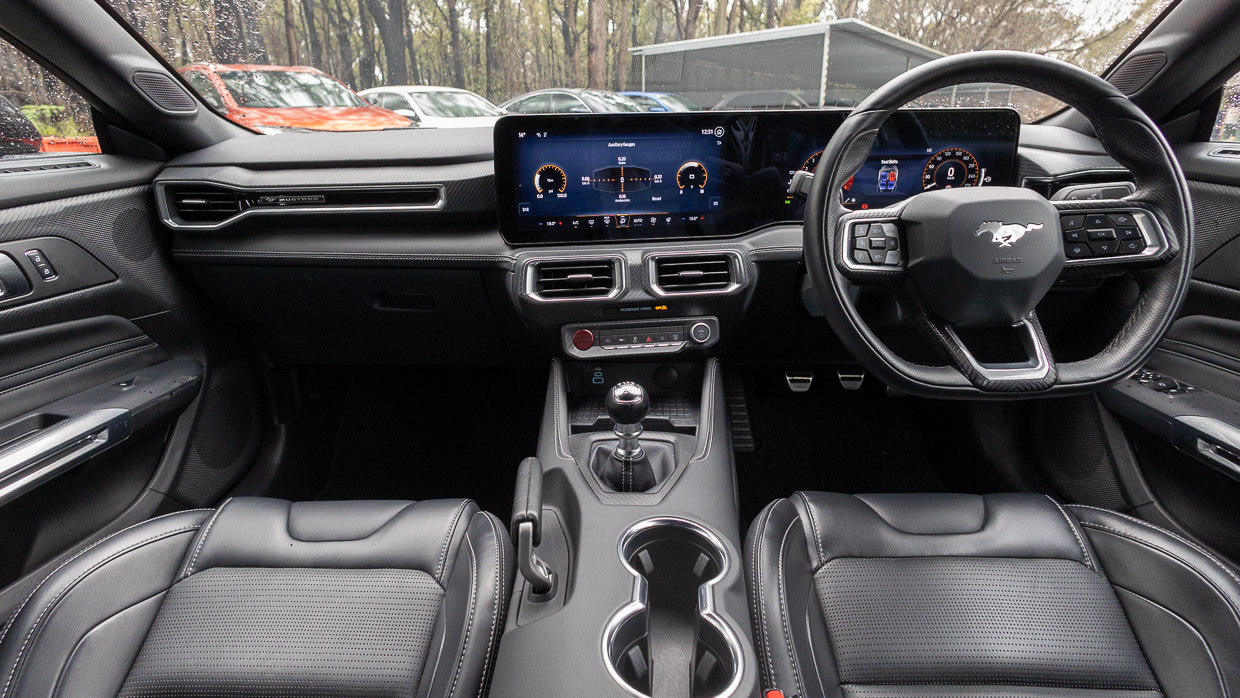
This introduces an expanse of screens incorporating a 12.4-inch customisable instrument cluster offering various ‘heritage’ gauge displays, plus a classy contemporary one.
And this flows into a 13.2-inch centre touchscreen that wirelessly connects to Apple CarPlay/Android Auto and plays through a 12-speaker B&O system with a boot-mounted subwoofer.
So far, the screens have been easy to navigate and great to look at, while the CarPlay has proved reliably slick 98 percent of the time.
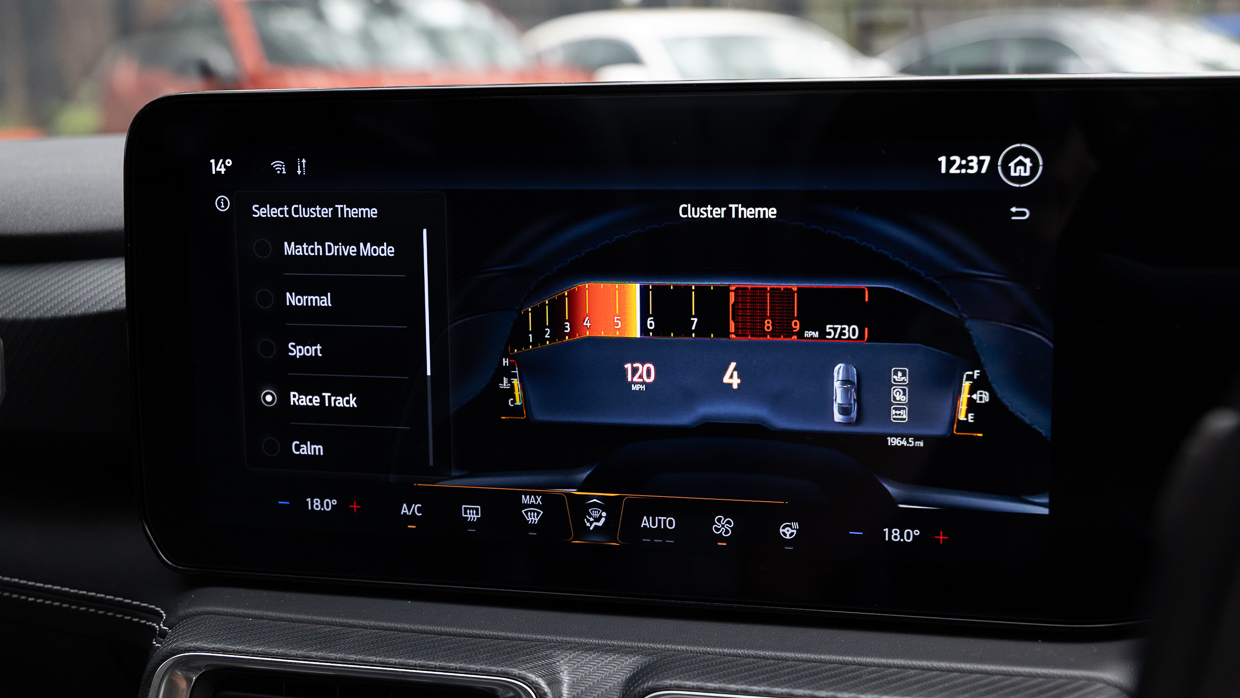
As for the heart of the matter – Ford’s 345kW/550Nm 5.0-litre V8 tied to a six-speed manual – it’s great! Even with the active exhaust system in Normal, there’s a tonne of bassy, barky bent-eight rumble bellowing from the four rear exhaust pipes. And then there’s Sport and Racetrack modes on top of that!
I’ve set the Mustang up in its Custom Mode setting via the left steering-wheel spoke (which you need to select each time you start the car) to switch to Sport exhaust – it’s more than enough rumble and muscle – though you can also do that via the ‘Pony’ symbol at the base of the centre console.
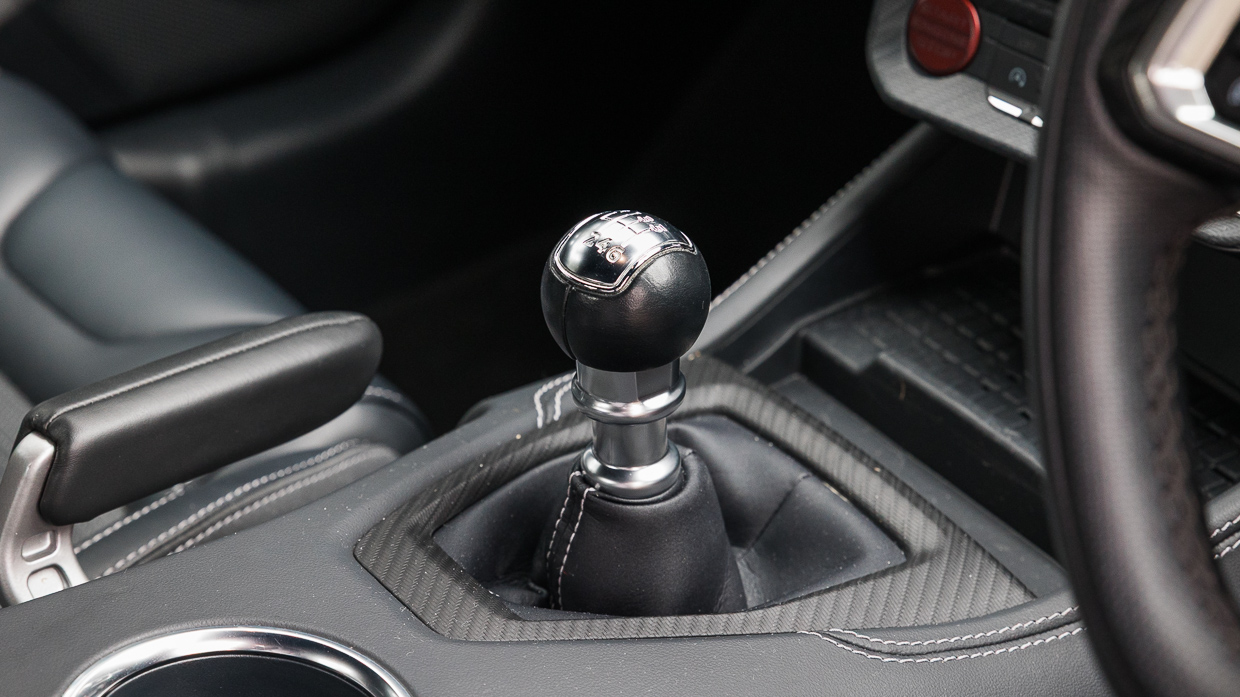
And the manual transmission? Honestly, it’s one of the most fluid, easy-to-select and satisfying manuals I’ve ever driven. Forgiving, even! It doesn’t make demands of its driver at all. Instead, it delivers a lovely, well-defined action, combined with brilliant clutch feel and excellent clutch weighting (firm yet pliant).
So far, the Mustang GT is one of the easiest manuals I’ve ever driven because it’s so positive and communicative, rather than mushy, over-sensitive, heavy or wooden.
And the naturally aspirated V8 is a breeze – pulling without complaint from just 800rpm yet revving all the way to 7250!
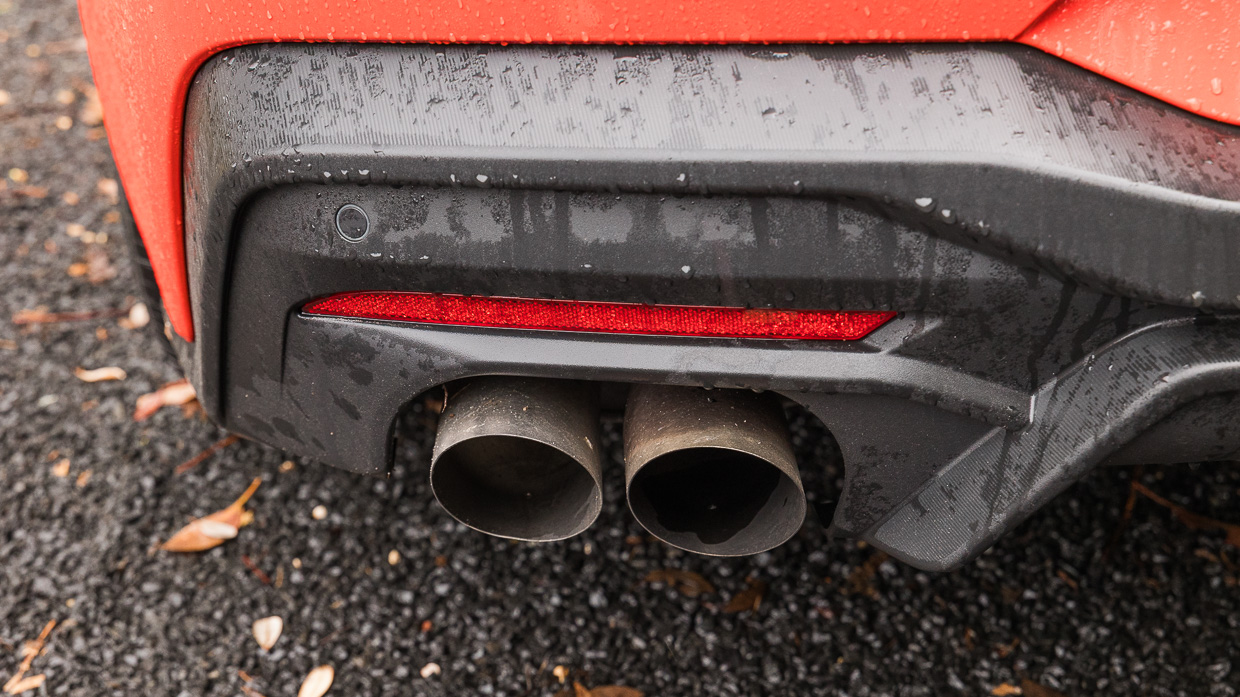
Admittedly, there isn’t much happening down that low when it comes to performance, and the Mustang’s V8 is a little strained up to too – as if it’s air-restricted. But the need to fully rev it out is virtually non-existent, because it’s so tractable, amenable and likeable.
Next month we’ll going into more detail about the Mustang GT’s liveability – covering everything from ride quality to boot space, and the expected fuel-economy analysis. But for now, I’m really loving Big Red.

From its tough-looking tail to its frameless doors, great stance, meaty sound and surprisingly sweet drivetrain feel, it’s already proving to be a far-superior beast to its S550 predecessor.
And even with 8000km already under its belt on arrival, CUW-824 is remarkably tight. It feels just like a new car! May that impression continue over the coming months.
GWM Tank 500 Ultra Hi4-T PHEV 2026 Review
1 week ago

The Chinese manufacturer is making a big bet that plug-in hybrid power represents the future of the large 4WD segment — and first impressions are fairly positive
Good points
- PHEV delivers muscular performance
- Hi4-T system keeps mechanical 4WD
- Suitably soft, plush demeanour
- Very generous spec at $80k
Needs work
- Lacks GWM’s new infotainment…
- …so it soldiers on with laggy tech
- Heavy, so doesn’t feel 300kW quick
- Very inefficient on battery power
The real purpose of GWM’s decision to lob a plug-in hybrid (PHEV) version of its cut-price Prado-rivalling Tank 500 four-wheel drive into the Australian market for $79,990 driveaway will become clear in the next year or two.
Already available locally with a ‘plugless’ petrol/hybrid (HEV) drivetrain (from $64,490 d/a), the Tank 500 PHEV adds more power and torque, around 100km electric driving range, and the ability to power external appliances from its battery while retaining true 4WD and 3000kg towing—all convenient ‘nice to haves’.

But all of those attributes are secondary to the fact the Tank 500 PHEV is designed to not just comply with Australia’s new vehicle emissions laws and avoid carbon penalties — but to generate such little CO2 (on paper) that the plug-in Tank 500 earns carbon credits!
These new emissions laws, dubbed NVES, will be financially punishing for carmakers that sell too many petrol/diesel vehicles, and not enough EVs and PHEVs. The likes of Toyota, Ford and Isuzu are all in that situation. One obvious way to pay off NVES fines for carmakers that receive them is to increase vehicle pricing.
Hence GWM’s big, early bet on PHEVs, even in heavy-duty segments like this. While rivals work out their NVES strategy, this Chinese brand is hoping to coax buyers into PHEVs right now, banking carbon credits and keeping prices lower than rivals — in theory.
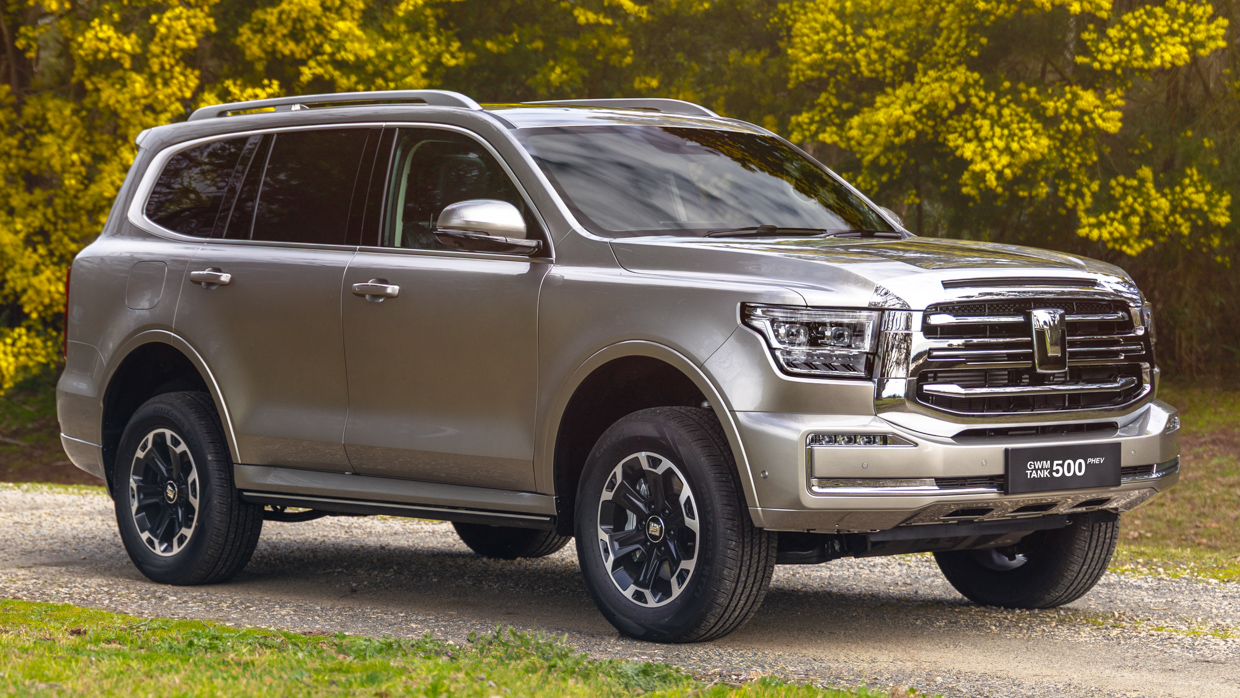
Available only in high spec ‘Ultra’ trim, the Tank 500 PHEV initially looks to be off to a good start. Producing 300kW of combined power and lavished with massaging, heated, cooled nappa leather among other toys, its sub-$80,000 on-road price means it costs little more than a cloth-trimmed, base diesel Toyota Land Cruiser Prado GX.
At Ultra level, other standard kit takes in 18-inch alloys (with a PHEV-specific design), LED exterior lighting, side steps, panoramic opening sunroof with shade, 12-speaker Infinity stereo, 14.6-inch touchscreen, head-up display, wireless charger, ambient lighting, acoustic glass and keyless entry.
However, it’ll take more than eye-opening pricing to convince Australians to give new-world hybrid tech a chance in the 4WD class, and the regular Tank 500 HEV is currently struggling — generating just 1117 sales year-to-date, compared to over 21,000 Prados.

That is a massive gulf, but senior insiders suggest they expect the pricing of rivals like the Prado, Everest and MU-X will simply have to increase, leaving the lushly specified Tank 500 looking like better-and-better value over time.
How does the Tank 500 Hi4-T PHEV drive?
GWM Australia was able to choose between two very different versions of the Tank 500 PHEV. The choice was made for the heavy-duty ‘Hi4-T’ configuration that retains mechanical 4WD system with dual-range transfer case and electric-locking front and rear differentials. While it has an electric motor, this comes before the nine-speed transmission.
Overseas, a road-focused ‘Hi4-Z’ version of the Tank 500 is also available. This iteration has a bigger hybrid battery, double the electric range, and double the power — but it dispenses with true 4WD in favour of dual-motor electric AWD. Expect to see Hi4-Z come to Australia in future, but not in a Land Cruiser rival.

GWM believes the Tank 500 PHEV will have more ‘cred’ if it can tow with consistent performance (it’s rated for 3000kg braked) and go further off-road, meaning the PHEV system mostly adds to the car’s capability rather than detracting from it.
On the road, the driving experience of the PHEV is much like the regular Tank 500 hybrid — but with fewer hiccups from the powertrain thanks to superior calibration.
The standard hybrid and the PHEV share the same 180kW/380Nm 2.0-litre turbo petrol four-cylinder engine, but the PHEV gets a considerably more powerful 120kW/400Nm electric motor (instead of 78kW/268Nm) sandwiched between the petrol and the transmission.
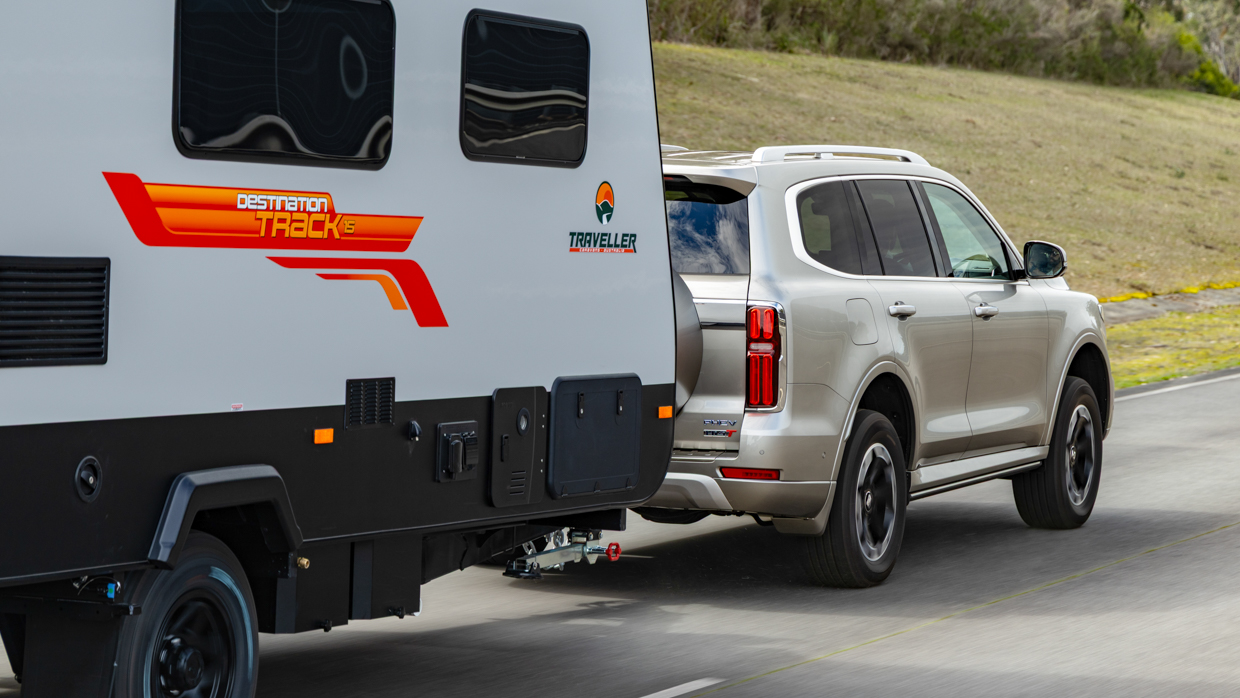
That upgrade takes combined power to 300kW/750Nm for the PHEV — a noticeable lift over the 255kW/648Nm claims of the hybrid. That’s good enough to slash the 0-100km/h run to 6.9 seconds (claimed), down about 1.5 seconds.
A key problem the regular Tank 500 hybrid is that power delivery is very inconsistent, because the battery is too small to keep the powertrain supplied with sufficient electric power to supplement the relatively modest petrol engine.
That is less of an issue in the PHEV because the battery management system keeps more charge in reserve — allowing the plug-in Tank 500 to deploy more of its total combined power, more of the time.
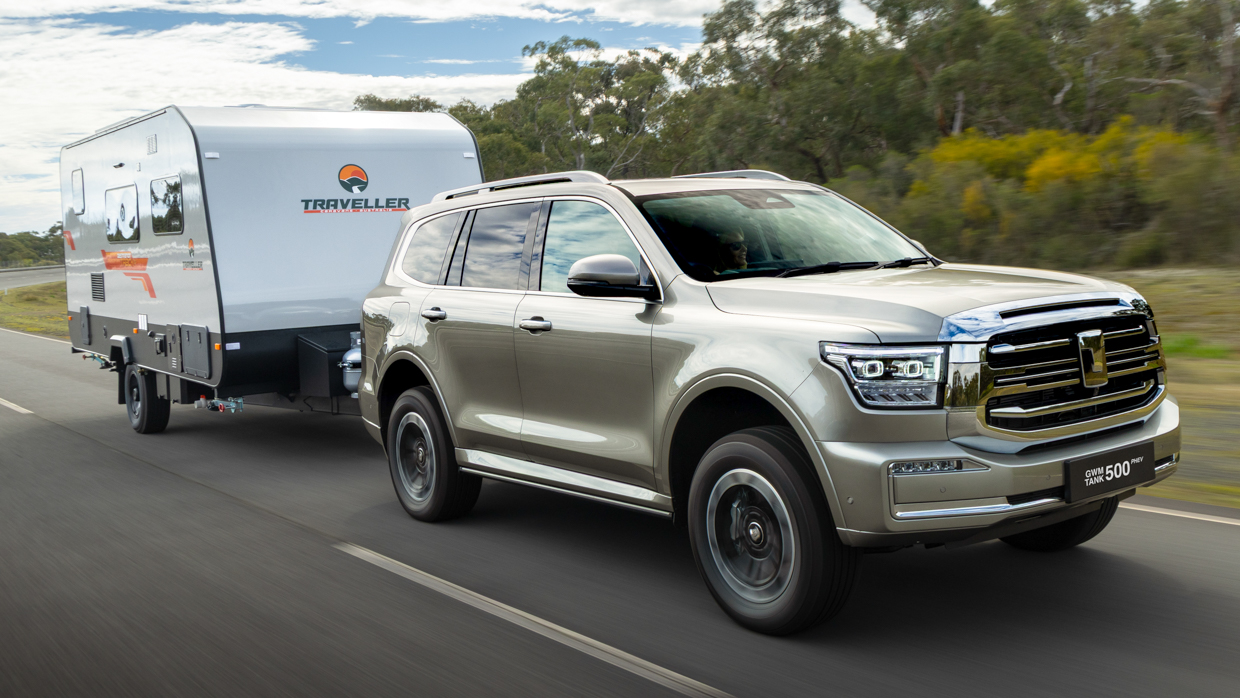
Getting the best of the PHEV powertrain will still require charging it up, however. Do so and you can extract all that combined power, or alternatively, run the Tank 500 PHEV on battery power alone for around 102km (WLTP est).
The EV-only range equates to efficiency of 36kWh/100km … not great, but still cheaper than running on petrol if you can charge at home. Once the battery is exhausted (with only a mandatory buffer remaining), fuel consumption sits around 10.0L/100km, being slightly better than the regular hybrid model.
Our initial testing loop occurred at the Lang Lang Proving Ground where GWM has established a steering and suspension tuning operation to localise the ride and handling of the models it sells in Australia. The Tank 500 hasn’t been adjusted yet.
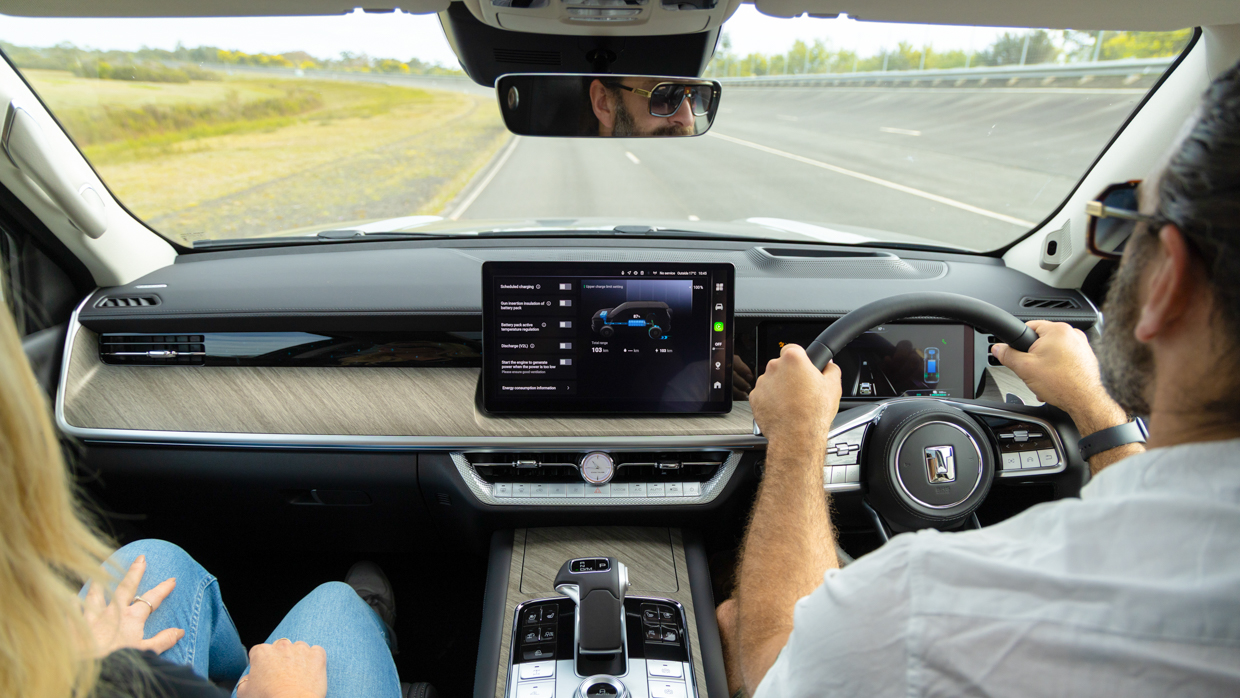
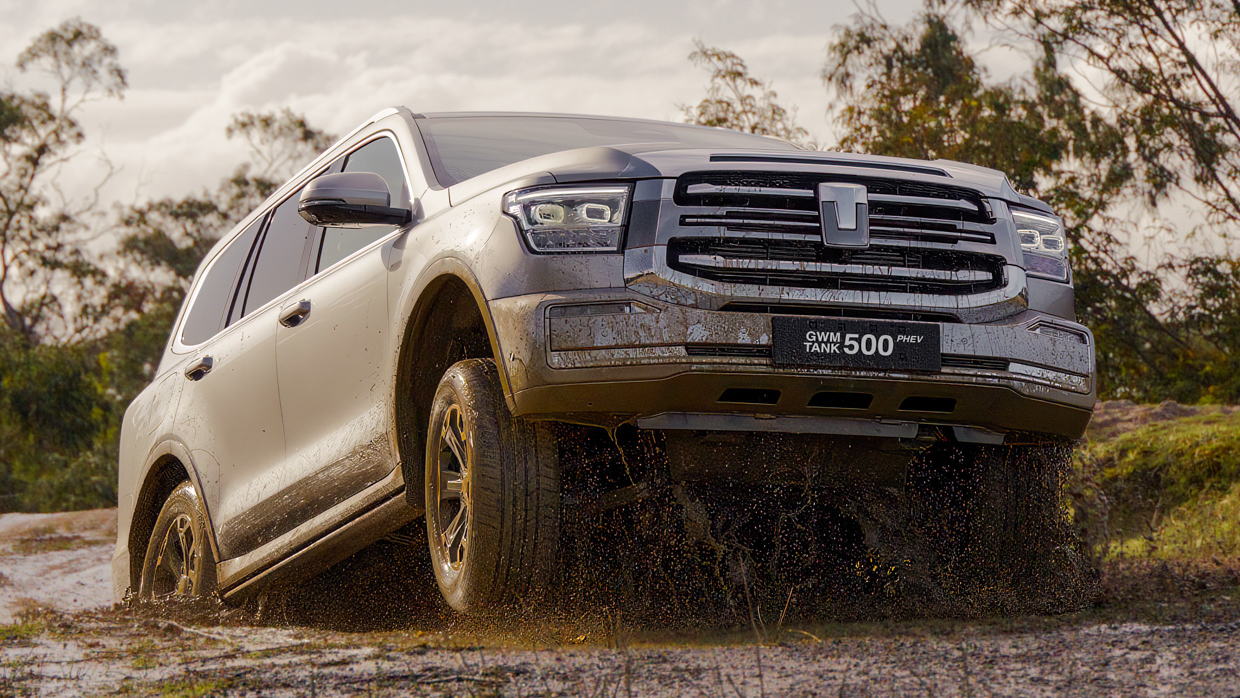
Lang Lang gave us the opportunity to drive the Tank 500 PHEV off-road and on a near-perfect simulation of Australian country roads. Both scenarios showed off a powertrain that feels muscular, refined and smooth, if not outrageously fast, as the plug-in weighs 2775kg!
The off-road course’s gnarly descents challenged the Tank 500’s 24-degree departure angle beyond its limits, causing some damage, but otherwise progress was smooth. Keep in mind, though, the PHEV appears to reduce ground clearance marginally, from 224mm to 213mm.
What we couldn’t test was towing. GWM says it chose Hi4-T partially because it allows for consistent towing performance no matter the state of charge, but we’d be keen to see how the system holds up on long uphill stretches — as the 180kW/380Nm petrol engine’s outputs may start to feel stretched here. We’ll see in future.

While the Tank 500’s ride and handling hasn’t received the same impressive local retune as the new GWM Haval H6 PHEV (tested on the same day), the big Tank starts from a higher base and doesn’t require an adjustment as urgently.
The slow steering could certainly do with a remap for more precision and feel, especially on-centre, but the soft and plush suspension tune arguably suits the laidback feel of this 4WD. Body control is a touch wayward but driven gracefully, the Tank 500 PHEV is relaxing.
We understand an Aussie rework of the shock absorbers and power steering is on the ‘to-do’ list for GWM’s dynamic engineers, led by ex-Holden guru Rob Trubiani.
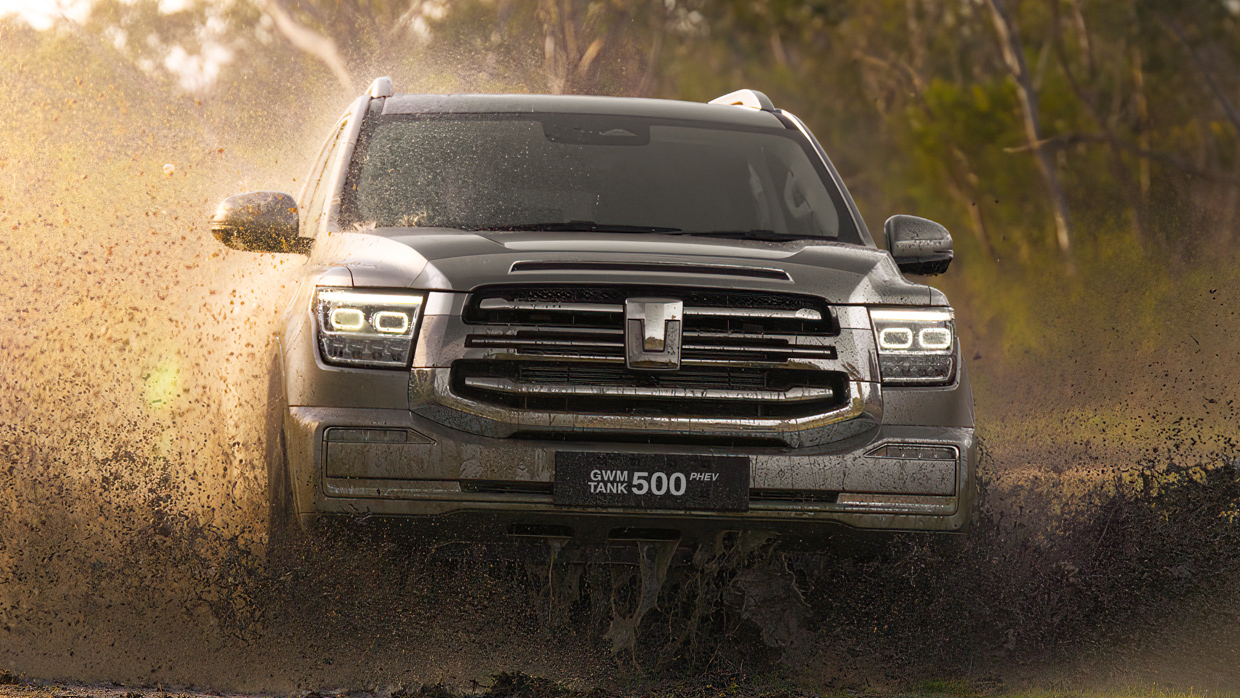
More finesse would also be appreciated from the safety systems. While the crisp 360-degree camera (with see-through mode) is very helpful, both the lane centring and driver fatigue detection systems are hypersensitive — and it’s a frustration to have to switch these off on every drive, as they come back on each time.
How is the Tank 500 Hi4-T PHEV’s interior?
With two major exceptions, the cabin of the Tank 500 PHEV is identical to that of the standard Tank 500 hybrid in Ultra trim — meaning lashings of nappa leather, plenty of toys and some tech that initially seems sophisticated … but turns out to be a little unintuitive.
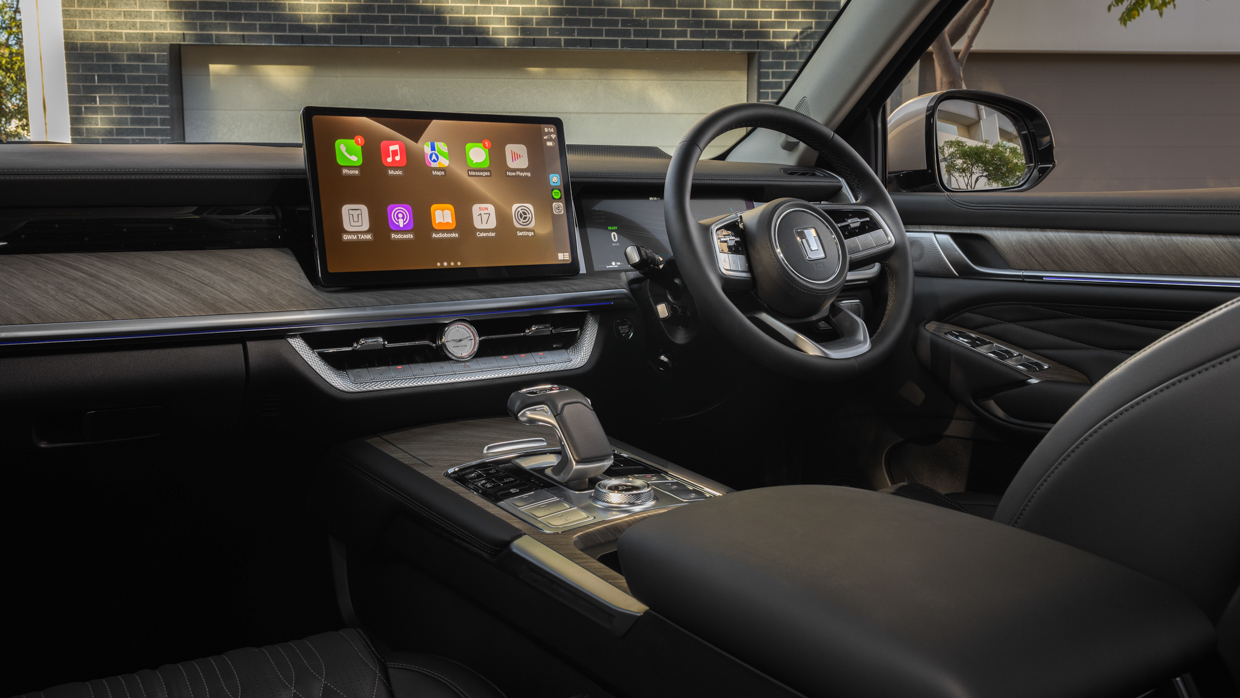
Those exceptions are that the PHEV’s larger battery has required the deletion of the regular Tank 500’s (well-packaged) third row — the plug-in is strictly a five-seater with a square-shaped 640-litre boot behind the second row, expanding to 1400L in two-seat mode.
The other big change is that second row comfort receives a big upgrade in the PHEV, which exclusively fits an executive-style back seat with a flip-down control console in place of a simple centre armrest.
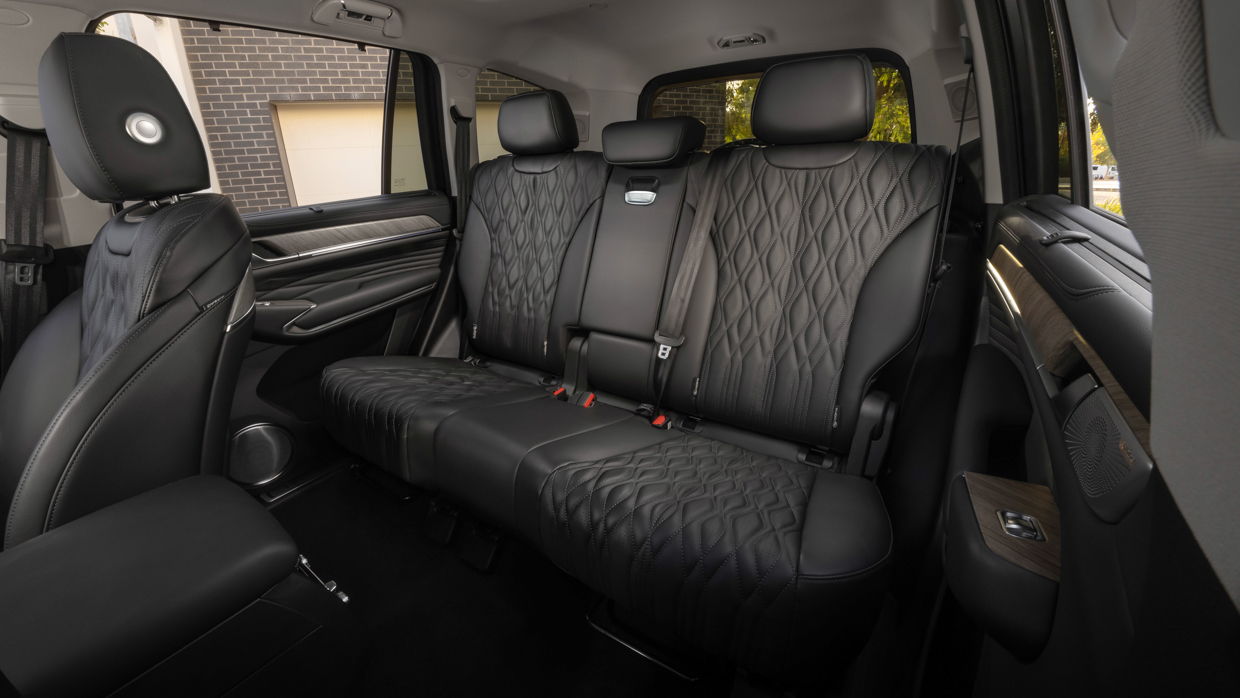
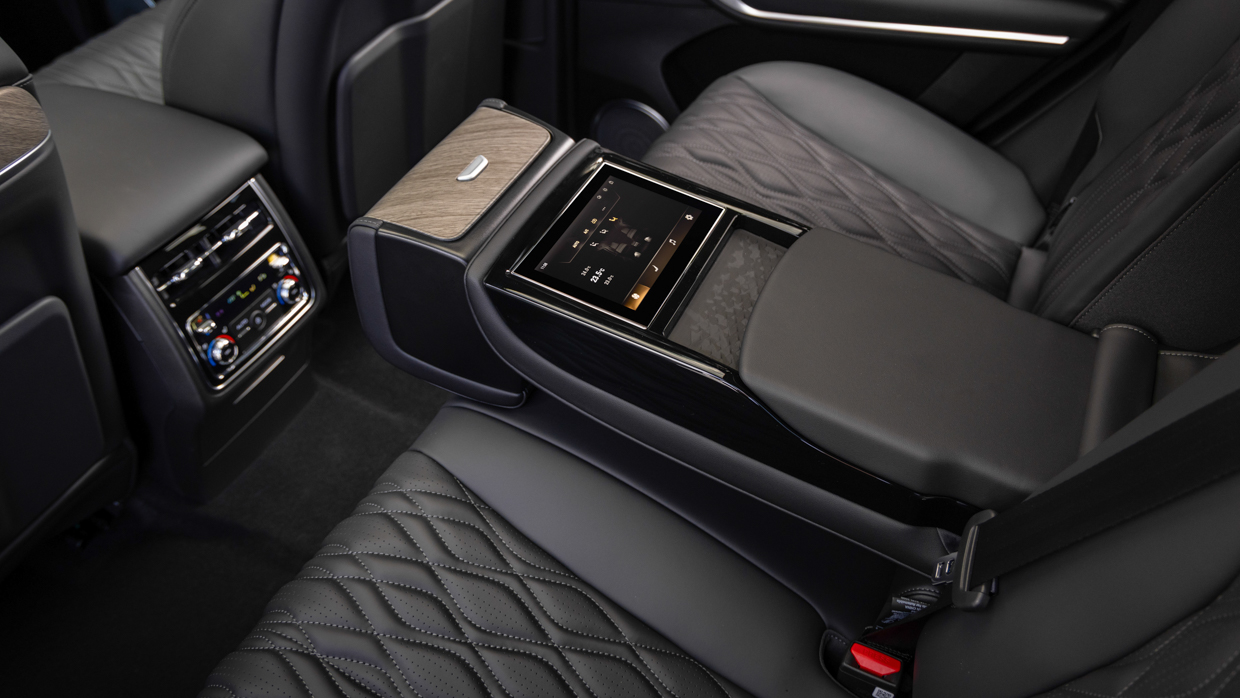
Instead, rear seat occupants get their own 7.0-inch touchscreen to control their heated, cooling, massaging outboard chairs — kids will be beside themselves playing with this! Back seat legroom and headroom is immense, and more spacious than any Prado.
Up front, comfort is decent. The Ultra-grade’s nappa-leather upholstery feels supple to the touch, with 12-way power-adjustment for the driver helping to achieve a solid driving position. The trim is black by default but an out-there cream/navy colour scheme is optional.
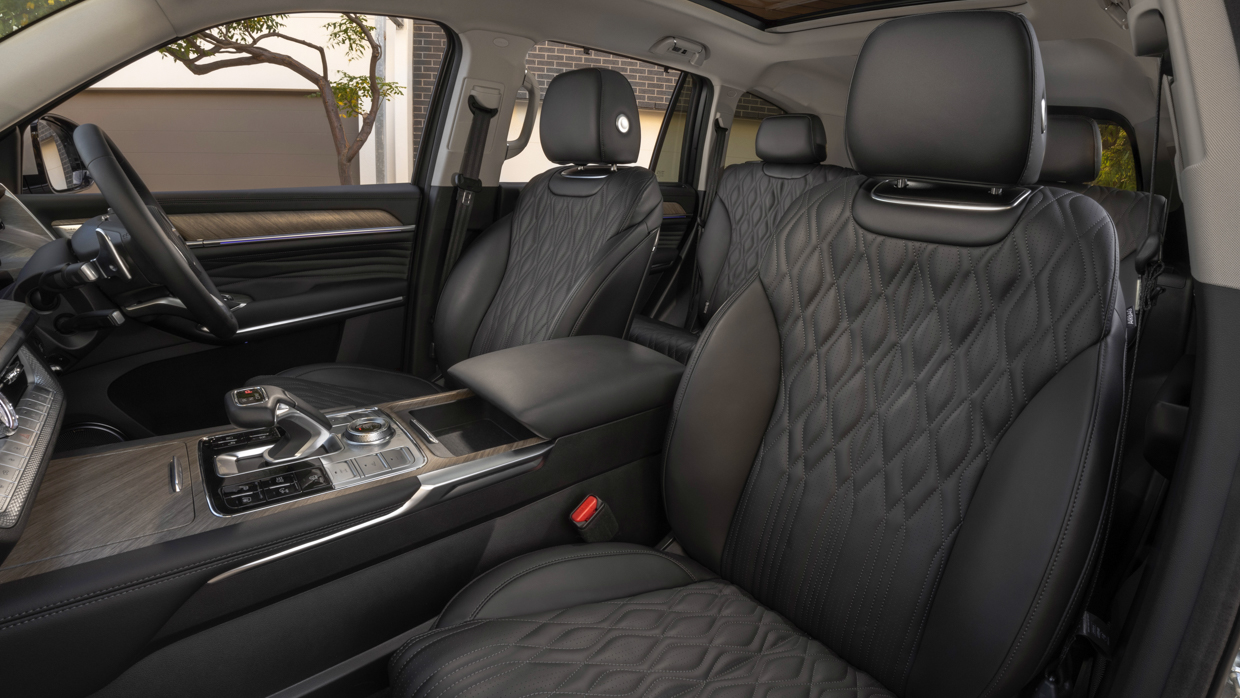
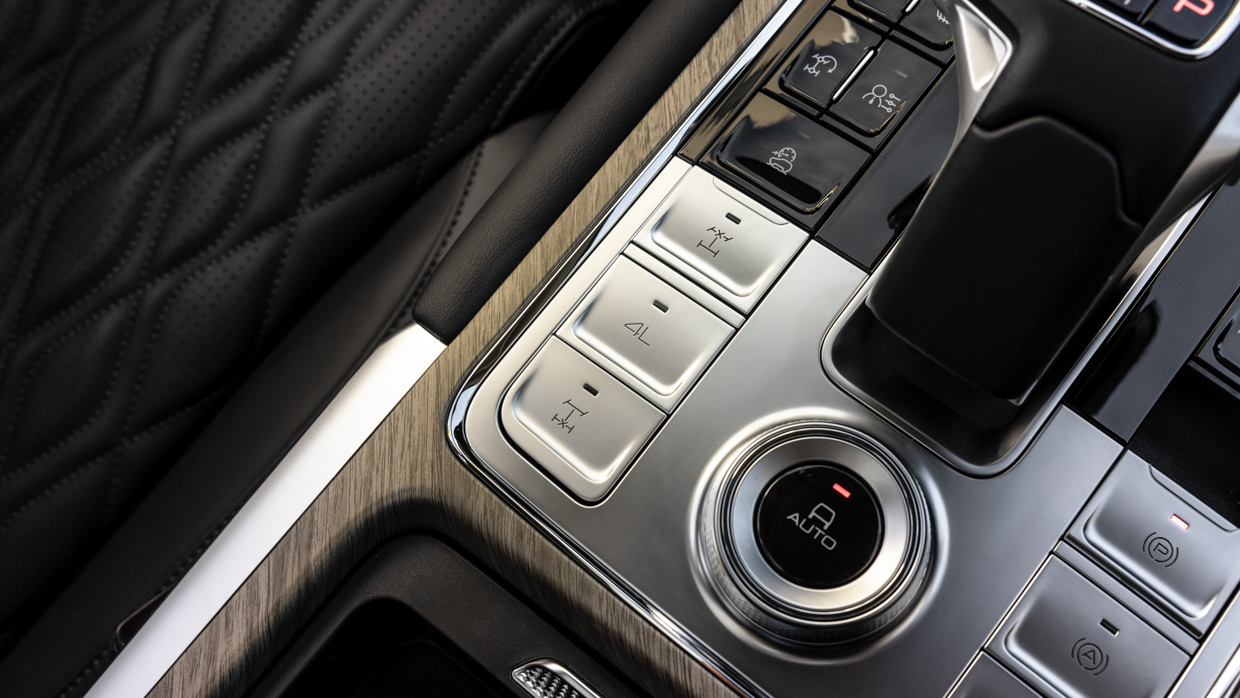
Sure, some of the secondary materials (from simulated wood to a few thinner veneers of soft-touch material) can look and feel slightly cheap but you have to remind yourself that the Tank 500 Ultra PHEV is only asking low-end Prado or mid-tier Everest money.
What needs more work is the cabin tech stack, and we expect this will be upgraded soon. GWM is in the early stages of rolling out its new ‘Coffee OS 3’ infotainment system, which bundles faster processing power with clearer screens and far more intuitive menus — meaning easier control of assistance and convenience features.

Because the Tank 500 hasn’t had its ‘Coffee’ upgrade yet, it soldiers on with an older, dimmer infotainment system that almost looks aftermarket. The 14.6-inch central touchscreen and 12-inch digital instrument cluster are large, but the fonts, colours and menus look amateurish.


There are little annoyances like the fact that, to adjust any climate control item, you have to be kicked out of Apple CarPlay or Android Auto. The newer GWM system has a fixed air-con control panel.
What is appreciated is the standard inclusion of a connected car app for your smartphone that allows you to start the Tank 500’s climate control and see telematics data in real time.

A further benefit of the PHEV that might initially be overlooked is the presence of a 6kW vehicle-to-load function. Appliances can be plugged into a standard power point, and in theory, the full load can be drawn for over six hours from a full battery charge.
The final verdict
GWM is moving quickly in Australia. The Chinese brand wants to rapidly increase market share, both by improving its products but also by seizing the initiative with vehicles that comply with Australia’s tough new emissions laws.
In theory, these laws should allow GWM to sell the Tank 500 PHEV more cheaply than the familiar diesels duking it out in the large 4WD segment. Toyota, Ford, Nissan, Isuzu — none have a hybrid ready for this segment. The Tank 500 now offers not one but two hybrid systems, both with seemingly little compromise.
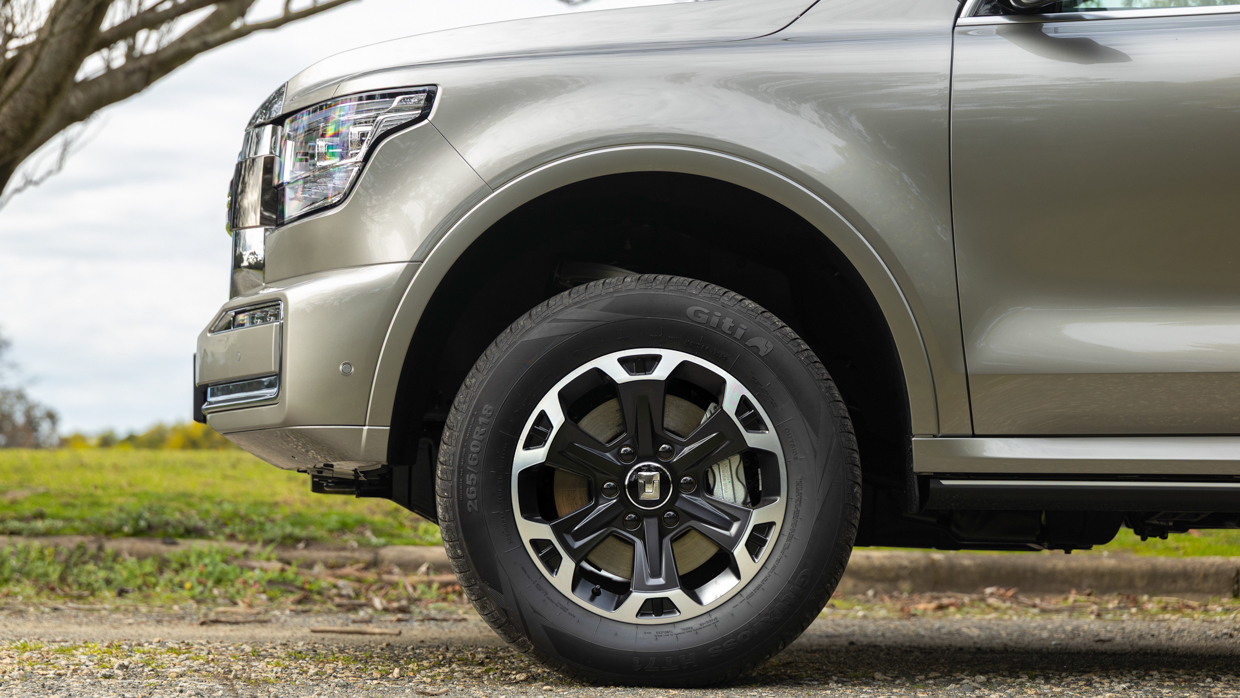
It’s very well to have well-priced, seemingly competent products ready to sell. Convincing Australians — particularly Aussies shopping in a segment that has not traditionally been interested in eco-conscious options — will require some novel marketing strategies. GWM says these campaigns will be revealed soon.
And moving this fast inevitably means that elements of the product can feel a touch underbaked. The Tank 500 PHEV arrives without an Aussie tune (for now) and without upgraded infotainment (for now). Both upgrades are likely to be worthwhile, and both could be justified reasons to wait for ‘version 2’.
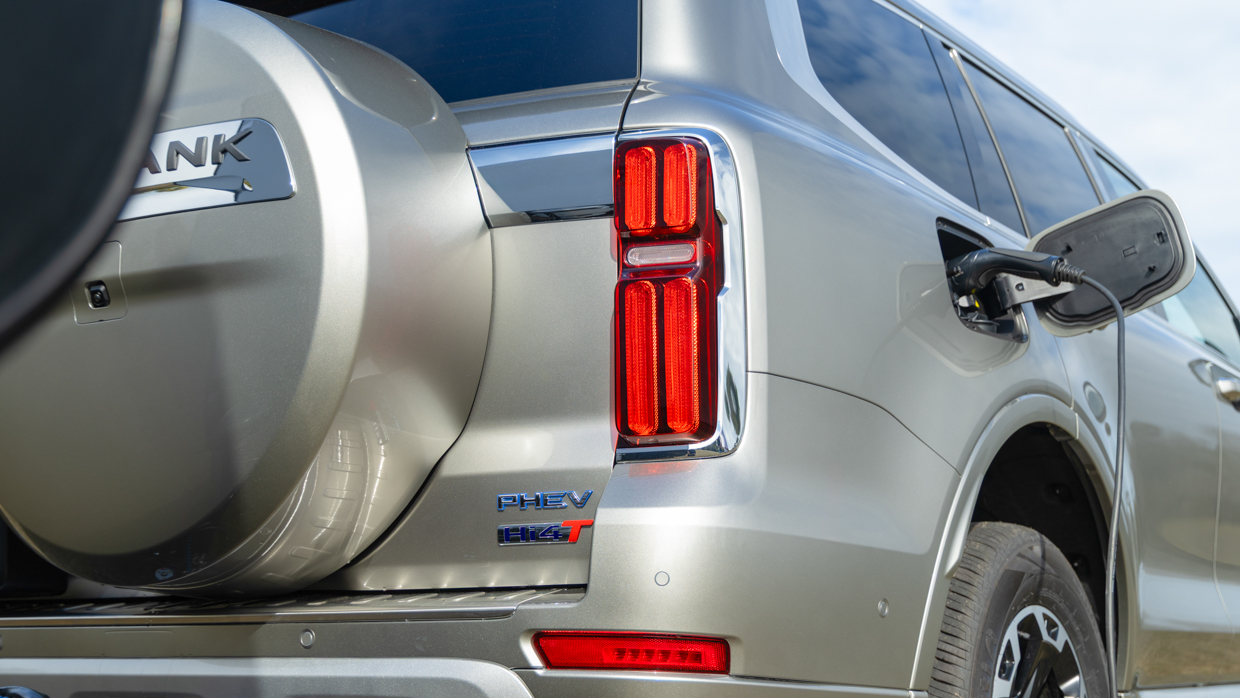
There is little doubt GWM is the cat amongst the pigeons in the large 4WD segment. Based on a first drive of the PHEV, we’re reasonably impressed. Next up will be a proper comparison to see the plug-in Tank compares outside the confines of the proving ground.



